Carestream Health DRXRGA Grid Alignment User Manual 00944
Carestream Health, Inc. Grid Alignment 00944
Safety and Regulatory Manual
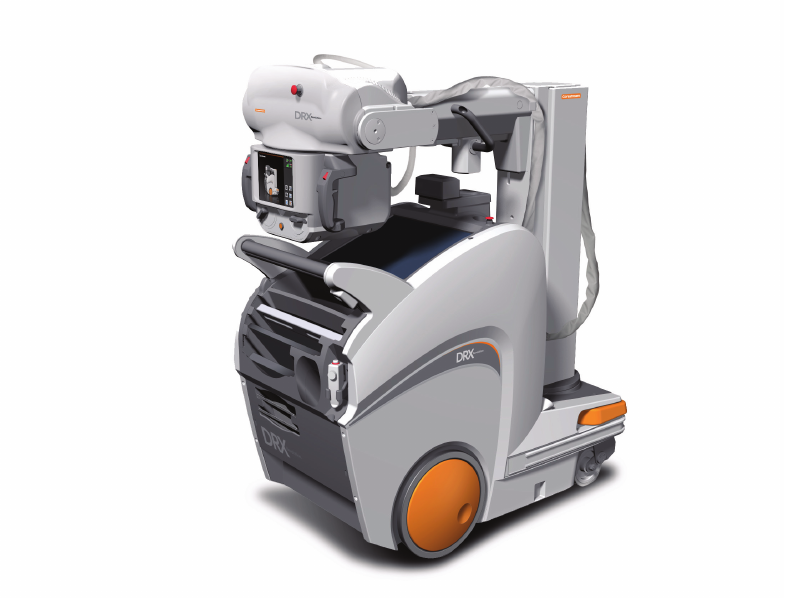
DRX-Revolution Mobile X-ray
System
Safety and Regulatory Information
2012-02-07
9J0239
Version 3.0

9J0239 1
Table of Contents
1 Safety and Regulatory Information
Manual Conventions............................................................................................................................................ 1
Overview ............................................................................................................................................................. 1
Indications for Use........................................................................................................................................ 2
Training ........................................................................................................................................................ 2
Safety and Related Information............................................................................................................................ 3
Manufacturer’s Responsibility ....................................................................................................................... 3
Safety Symbols............................................................................................................................................... 4
Radiation and X-ray System ........................................................................................................................... 6
Safety and General Compliance Information............................................................................................ 6
Maximum Permissible Dose (MPD)........................................................................................................ 7
Radiographic Performance ..................................................................................................................... 7
Radiation Protection ............................................................................................................................... 8
CDRH Compliance................................................................................................................................... 9
Classification in Accordance with IEC 60601-1........................................................................................ 9
IEC/EN 60601-1-3 Compliance................................................................................................................ 9
Conforming Safety Standards....................................................................................................................... 10
USA ....................................................................................................................................................... 10
Canada.................................................................................................................................................. 10
Europe.................................................................................................................................................. 10
International ......................................................................................................................................... 10
Cautions............................................................................................................................................................ 11
Equipment Cautions .................................................................................................................................... 11
Electrical/Mechanical.................................................................................................................................. 11
Mechanical ................................................................................................................................................. 11
General Use Cautions and Special Messages ................................................................................................ 11
Moving and Equipment Use Cautions........................................................................................................... 12
Electrical and Flammable Cautions.............................................................................................................. 12
Radiation and Magnetic Field Cautions........................................................................................................ 13
Cleaning Cautions........................................................................................................................................ 13
Caution Regarding Small-Object Image Handling ........................................................................................ 14
Restrictions on Use ..................................................................................................................................... 15

29J0239
Disposal............................................................................................................................................................ 16
Usability............................................................................................................................................................ 16
USB, Network, and Tether Connectors .............................................................................................................. 17
Conforming EMC Standards .............................................................................................................................. 18
For European Market Only.......................................................................................................................... 18
System Requirements.................................................................................................................................. 18
US and Canada EMC Statements .................................................................................................................. 19
Electromagnetic Emissions/Immunity ......................................................................................................... 20
Wireless............................................................................................................................................................ 28
DRX-Revolution Wireless Systems ............................................................................................................... 28
DRX-1 and DRX-1C System Detectors.................................................................................................... 28
Grid Alignment Transmitter................................................................................................................... 28
Wireless Compliance Information for EU Directive 1999/5/IEC................................................................... 29
Grid Alignment Intended Use ................................................................................................................ 29
EC Declaration of Conformity............................................................................................................................ 30
National Usage Restrictions......................................................................................................................... 31
Compliance................................................................................................................................................. 32
Anti-Collision Feature........................................................................................................................................ 35
Patient Vicinity .................................................................................................................................................. 35
Compatible Components ................................................................................................................................... 35
X-ray Tube Components.............................................................................................................................. 35
X-ray Source Assembly................................................................................................................................ 35
Accessories................................................................................................................................................. 36
Flammability ............................................................................................................................................... 36
Method of Cleaning..................................................................................................................................... 36
Extra Focal Dimensions .................................................................................................................................... 37
Labels ............................................................................................................................................................... 39
Systems Label Locations.............................................................................................................................. 39
Detector /Grid Holder Weight Limit Label ................................................................................................... 41
Product Disclosure Table.................................................................................................................................. 42

1-1 9J0239
Safety and Regulatory Information
1
Safety and Regulatory
Information
The information contained herein is based on the experience and knowledge
relating to the subject matter gained by Carestream Health, Inc. prior to
publication.
No patent license is granted by this information.
Carestream Health, Inc. reserves the right to change this information without
notice, and makes no warranty, express or implied, with respect to this
information. Carestream Health shall not be liable for any loss or damage,
including consequential or special damages, resulting from any use of this
information, even if loss or damage is caused by Carestream Health’s
negligence or other fault.
Manual Conventions
NOTE: The original documentation is written in English.
This manual uses three types of messages to emphasize information or
potential risks to personnel or equipment: Note, Important and Caution.
NOTE: Notes provide additional information, such as expanded
explanations, hints, or reminders.
IMPORTANT: Important highlights critical policy information that
affects how you use this manual and this product.
CAUTION:
Cautions point out procedures that you must follow precisely
to avoid injury to yourself, others, damage to the system or any
of its components, loss of data, or corruption of files in
software applications. Disregarding the caution statement may
lead to abnormal use.
Overview
The CARESTREAM DRX Mobile X-ray System is a mobile imaging system that
incorporates a self contained X-ray generator, image receptor, imaging
display and software for acquiring medical diagnostic images outside a
standard X-ray room. It is a mobile diagnostic system intended to generate
and control X-rays for examination of various anatomical regions.

1-2 9J0239
Safety and Regulatory Information
The system is designed for use in all locations of a hospital or clinical site,
including patient rooms, operating rooms, emergency departments, trauma
bays, Intensive Care Units (ICU) and other patient treatment areas.
Personnel operating and maintaining the System should receive training and
be familiar with all aspects of operation and maintenance. To ensure safety,
read the Safety Information section carefully before using the system and
observe all Cautions, Importants, and Notes located throughout this
manual and other manuals supplied with the equipment.
From this point forward, all references to the DRX -Revolution System will be
referred to as the System.
Indications for Use The device is designed to perform radiographic X-ray examinations on all
pediatric and adult patients, in all patient treatment areas.
Training This equipment is intended for use by appropriately trained and skilled
radiological health care professionals who have received specific training on
the operation and use of this equipment.
CAUTION:
Only qualified personnel may operate the System. Operation of
the equipment by persons who have not been trained or who
are unfamiliar with the functions and controls of the System
may cause serious injury to the patient, serious injury to the
operator, or equipment damage.
CAUTION:
Only allow trained X-ray personnel to operate the system.
For training in the operation of this equipment, contact Carestream Health,
Inc.

1-3 9J0239
Safety and Regulatory Information
Safety and Related Information
Manufacturer’s
Responsibility
Although this equipment incorporates protection against X-radiation other
than the useful beam, practical design does not provide complete protection.
Equipment design does not compel the operator or assistants to take the
necessary precautions; nor does it prevent the possibility of improper use
(authorized or unauthorized persons carelessly, unwisely, or unknowingly
exposing themselves or others to direct or secondary radiation). Allow only
authorized, properly trained personnel to operate this equipment.
Be certain that all individuals authorized to use the equipment are aware of
the danger of excessive exposure to X-radiation.
This equipment is sold with the understanding that the manufacturer, its
agents, and representatives do not accept any responsibility for overexposure
of patients or personnel to X-radiation.
Furthermore, the manufacturer does not accept any responsibility for
overexposure of patients or personnel to X-radiation generated by this
equipment as a result of poor operating techniques or procedures.
No responsibility is assumed for any unit that has not been serviced and
maintained in accordance with the technical service manual, or that has been
modified or tampered with in any way.
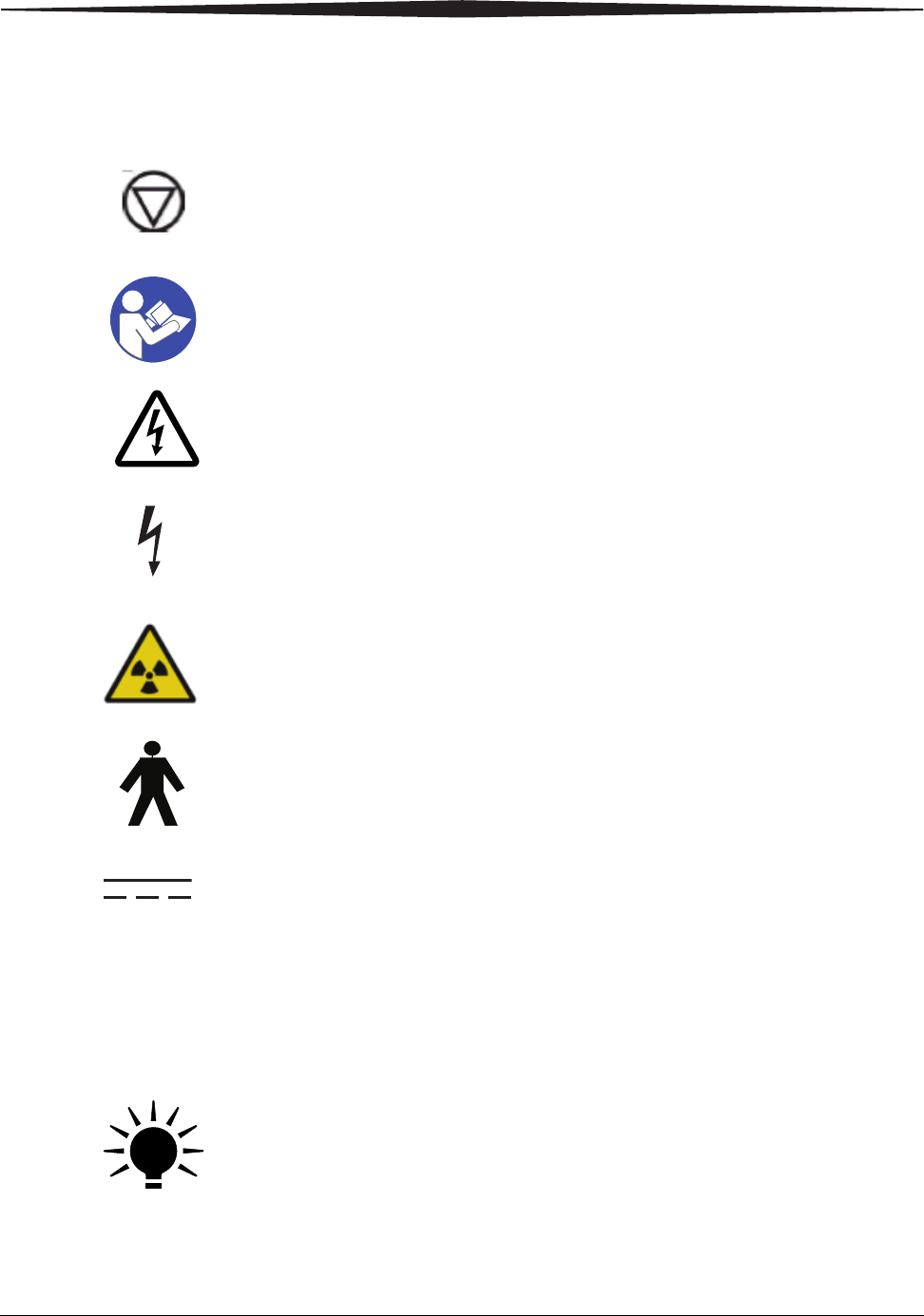
1-4 9J0239
Safety and Regulatory Information
Safety Symbols The following symbols may be used for marking on this equipment for
equipment documentation.
Emergency Stop button
Follow operating instructions
Warning—dangerous voltage
Dangerous voltage
Warning— ionizing radiation
Type B applied part
Direct current
Alternating current
Collimator light
~
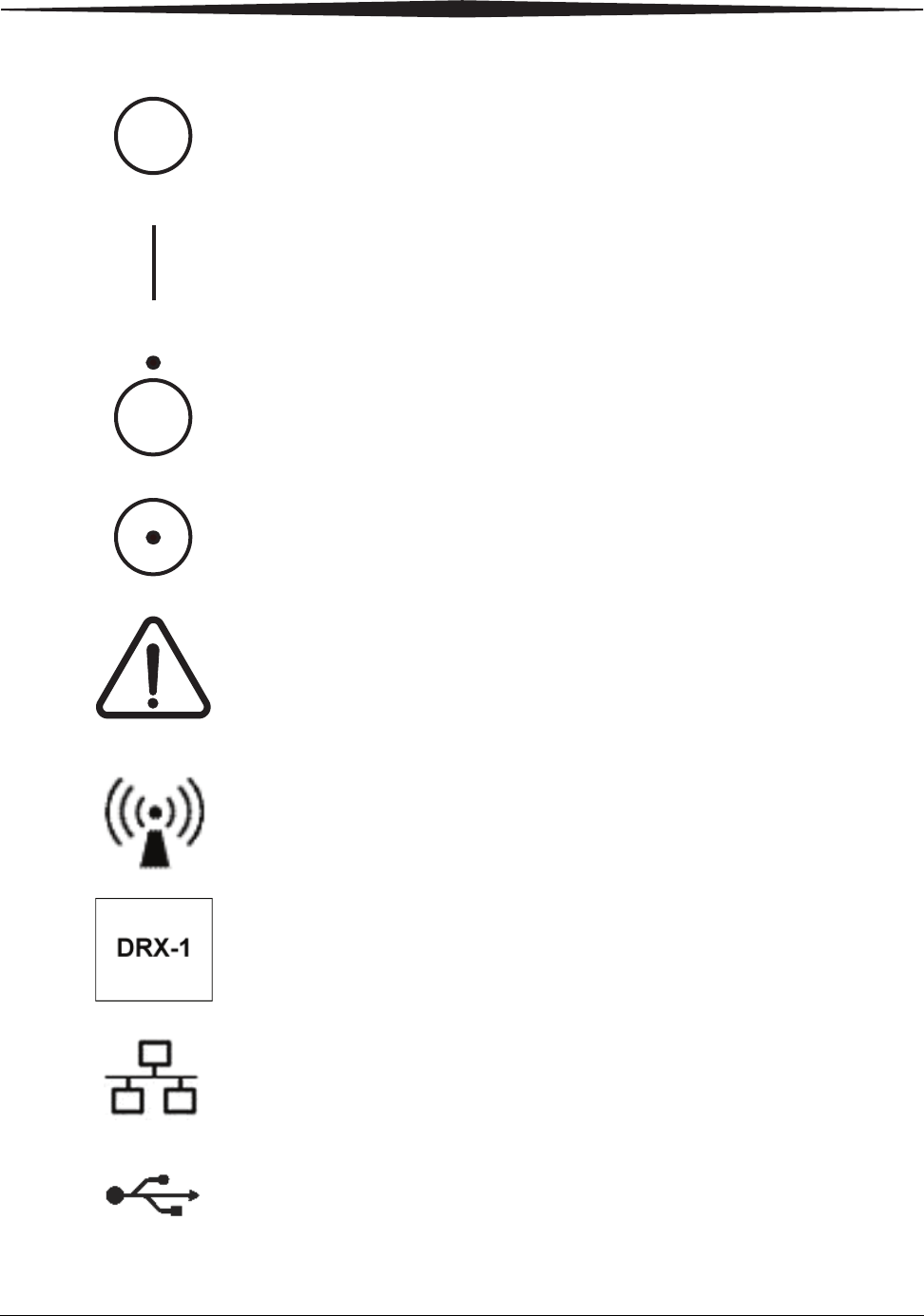
1-5 9J0239
Safety and Regulatory Information
Power Off
Power On
Equipment Off
Equipment On
Caution
Non-ionizing radiation
Tether cable
Ethernet connection
USB connection

1-6 9J0239
Safety and Regulatory Information
Radiation and X-ray
System
Safety and General
Compliance
Information
Occupational workers associated with X-ray work must be familiar with the
recommendations of the Center for Devices and Radiological Health (CDRH),
the National Council on Radiation Protection (NCRP), the International
Commission on Radiation Protection (ICRP), and state and local regulations.
Be sure that all personnel authorized to operate the System are familiar with
the established regulations of the authorities named above. All personnel
should be monitored to ensure compliance with recommended procedures.
Current sources of information include:
• NCRP Report 147: Structural Shielding Design for Medical Imaging
Facilities
• Current recommendations of the International Committee on Radiation
Protection
• State or local requirements for radiation protection
Although exposure to high levels of X-radiation may pose a health risk, System
X-ray equipment does not pose any danger when properly used. Be certain all
operating personnel are properly educated concerning the hazards of
radiation. Persons responsible for the system must understand the safety
requirements and special warnings for X-ray operation. Review this manual
and the manuals for each component in the system to become aware of all
safety and operation requirements.
CAUTION:
Ensure exposure parameters are properly adjusted within
safety limits.
CAUTION:
Incorrect Collimator adjustment may cause unnecessary
patient X-ray exposure. See the DRX-Revolution Mobile X-ray
System Hardware Guide for instructions for adjusting the size
of the exposure area.
CAUTION:
Incorrect X-ray Tube and Collimator position could cause the
X-ray field to be misaligned with the receptor, resulting in
unacceptable images.

1-7 9J0239
Safety and Regulatory Information
CAUTION:
Materials between the Tube and the patient may adversely
affect the resulting image.
Maximum Permissible
Dose (MPD)
Various studies on the effects of X-radiation have provided a foundation for
establishing the maximum permissible dose of X-radiation to which an
occupational worker may be exposed. The results of these studies have been
used by the NCRP and the ICRP to develop recommendations for MPD. In
addition, state or local regulators also provide occupational exposure limits
which must be complied with.
Occupational Exposure Limits:
Whole body: 5.0 rem/year
Extremity: 50.0 rem/year
Declared pregnant occupational worker: 0.5 rem/gestation period
Radiographic
Performance
kVp Range 40 to 150 kVp
kVp Accuracy ±(5 % + 1) kVp, measured 5 ms after the beginning of the exposure; ±2 % between
70–85 kVp
Ripple (kVp) ±5 % p–p over the full operating range (for ripple frequency kHz
Risetime (10– 90 %) < 2.0 ms (typically < 1.5 ms)
mAs Accuracy ±(10 % + 0.20) mAs: > 0.5 mAs
± (10 % + 0.5 mAs: 0.1 mAs–0.5 mAs
Coefficient of linearity 0.1 (Station to Station) for exposures mor 3.2 ms
Coefficient of
Reproducibility
< 0.05 for kVp and mAs parameters

1-8 9J0239
Safety and Regulatory Information
Radiation Protection Because exposure to high levels of X-radiation may pose a health risk,
operators must ensure that they use all available methods to reduce their
radiation dose to a level that is As Low As Reasonably Achievable (ALARA).
This includes protection from the primary beam as well as scattered
radiation. Protection from excessive amounts of exposure is accomplished
using a combination of engineering and administrative controls.
•Portable Barriers and Lead Aprons—Portable barriers and lead
aprons may be needed to protect personnel from scattered radiation if
operators need to be in close contact with the patient. Make sure that the
shielding and aprons have sufficient lead equivalence, as determined by a
qualified Health or Medical Physicist, and are maintained properly for
maximum benefit.
•Procedures—Always follow the procedures of your institution to ensure
proper protection.
•Training—Medical equipment should be operated by trained personnel
only. Most regulatory agencies require that medical diagnostic procedures
be done only by properly licensed individuals. Consult your state or local
agencies for more information.
•Radiation Survey—Monitor the exterior of the X-ray facility (outside the
primary protective barrier) and control room periodically to ensure that
dose rates meet design objectives for allowable radiation exposures. A
qualified Health or Medical Physicist should use only calibrated equipment
for this survey.
•Personal Monitoring—Monitor occupational workers that use X-ray
equipment for X-ray exposure to ensure that established controls are
functioning properly and procedures are being followed. Typically, film
badges or similar devices are used. Film badges use X-ray sensitive film
enclosed in a holder that incorporates metal filters of varying degrees of
transparency to X-ray radiation. Even though this device only measures the
radiation reaching the area of the body on which it is worn, it provides an
indication of the amount of radiation received. Film badges can also be
used as area dosimeters on the outside perimeter of the X-ray facility and
control room to verify dose rates.
Film badges are available from a number of distributors. Consult your
institution’s Radiation Safety Officer for further information.
IMPORTANT: Use a source-to-skin distance as large as possible to keep
the absorbed dose as low as reasonably achievable. The
Operator Console must be located where there is audio and
visual communication between the radiographer and the
patient.

1-9 9J0239
Safety and Regulatory Information
CDRH Compliance The X-ray System complies with Department of Health and Human Services
radiation performance standards per Title 21 CFR, Chapter 1, Subchapter J,
Section 1020.
Classification in
Accordance with
IEC 60601-1
IEC/EN 60601-1-3
Compliance
The System is manufactured with radiation protection in accordance with
IEC/EN 60601-1-3:1994.
Type of protection against electrical shock Class I equipment/Internally powered
Degree of protection against electrical shock Type B protection against electrical shock
Degree of protection against ingress of water Ordinary protection
Mode of operation Continuous operation with intermittent loading
Flammable anesthetics Not suitable for use in the presence of flammable anesthetics
or a mixture of flammable anesthetics with air or oxygen or
nitrous oxide
Electrical Rating
DRX-Revolution Mobile X-ray System Voltage: 100/120/200/240/ VAC
Current: 4.4/12.0/7.2/6.0 A
Frequency: 50/60 Hz
DRX-Revolution Grid Holder Voltage: 3.2 VDC
Current: 1.5 A
CARESTREAM DRX-1/DRX-1C System Detector Voltage: 3.2 VDC
Current: 3.0 A

1-10 9J0239
Safety and Regulatory Information
Conforming Safety
Standards
USA UL 60601–1:2003 Medical Electrical Equipment, Part 1: General
Requirements for Safety
Canada CAN/CSA–C22.2 No. 601.1–M90—Medical Electrical Equipment—Part 1:
General Requirements for Safety
Europe EN 60601–1:1990 + A1+ A2—Medical Electrical Equipment—Part 1:
General Requirements for Safety
EN 60601–1–1:2001—Medical Electrical Equipment—Part 1–1: General
requirements for safety —Collateral standard: Safety requirements for
medical electrical systems
EN 60601–1–3:1994—Medical Electrical Equipment—Part 1–3: General
requirements for safety—3. Collateral standard: General requirements for
radiation protection in diagnostic X-ray equipment
EN 60601–1–4:1996 +A1—Medical Electrical Equipment—Part 1–4:
General requirements for safety—Collateral standard: Programmable
electrical medical systems
EN 606011–6:2004—Medical Electrical Equipment—Part 1–6: General
requirements for safety—Collateral standard: Usability
EN 60601–2–32:1994—Medical Electrical Equipment—Part 2–32:
Particular requirements for the safety of associated equipment of X-ray
equipment
International IEC 60601–1:1988 + A1 + A2—Medical Electrical Equipment—Part 1:
General Requirements for Safety
IEC 60601–1–1:2000—Medical Electrical Equipment—Part 1–1: General
requirements for safety—Collateral standard: Safety requirements for
medical electrical systems
IEC 60601–1–3:1994—Medical Electrical Equipment—Part 1–3: General
requirements for safety —3. Collateral standard: General requirements for
radiation protection in diagnostic X-ray equipment
IEC 60601-1-4:1996 +A1—Medical Electrical Equipment—Part 1–4:
General requirements for safety—Collateral standard: Programmable
electrical medical systems
IEC 60601-1-6:2004 - Medical Electrical Equipment—Part 1–6: General
requirements for safety—Collateral standard: Usability
IEC 60601–2–32:1994—Medical Electrical Equipment—Part 2-32:
Particular requirements for the safety of associated equipment of X-ray
equipment
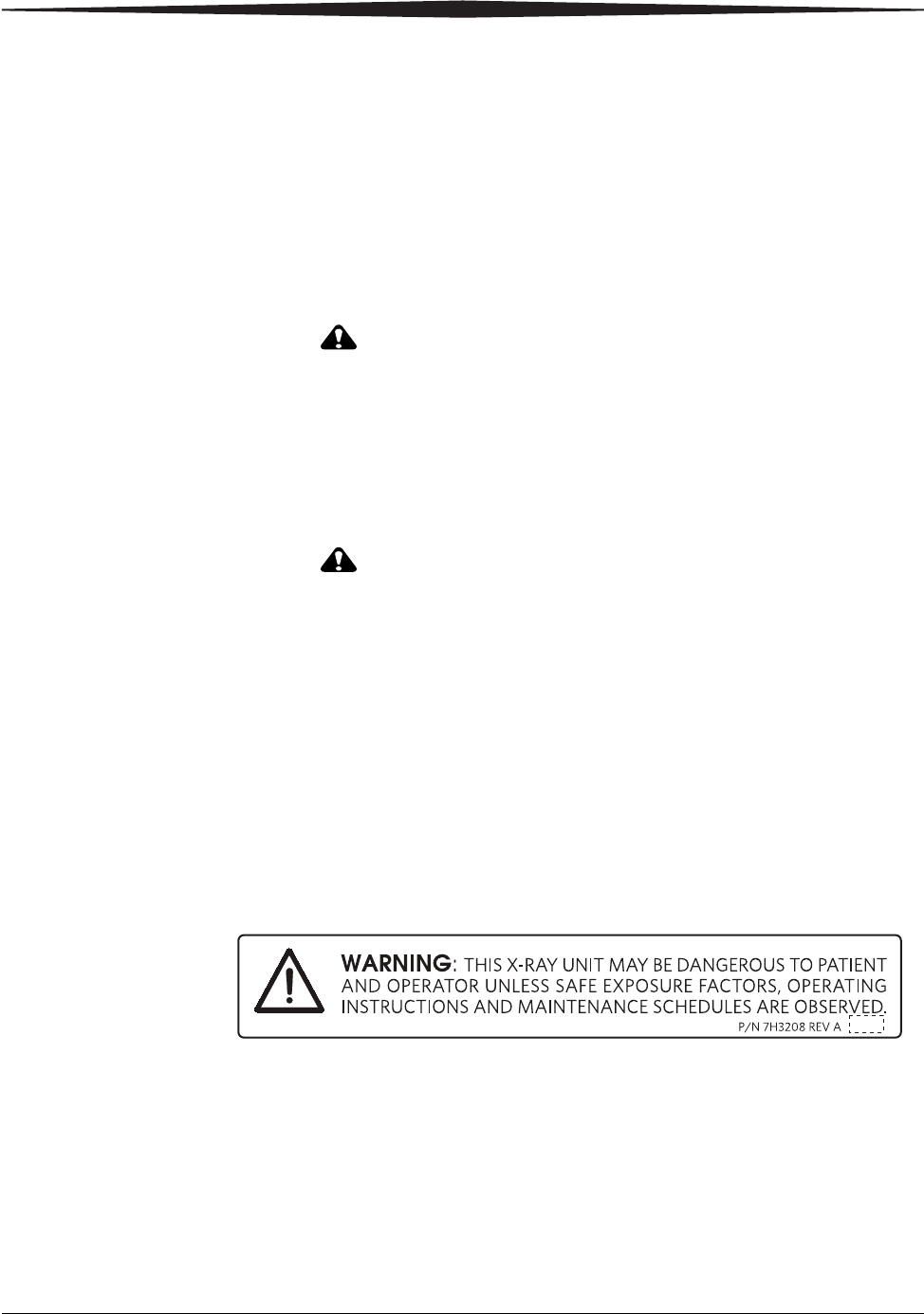
Safety and Regulatory Information
9J0239 1-11
Cautions
Equipment Cautions The following are general safety precautions:
• Do not remove the covers for any purpose.
• Do not defeat or bypass built-in equipment safety features.
• Observe all cautions, stated or implied, in the procedures.
• Follow all safety labels on the equipment.
CAUTION:
Do not attempt any repairs if the equipment fails to operate
correctly. Immediately call a person qualified and authorized
to repair the equipment.
Electrical/Mechanical
CAUTION:
Only a qualified authorized Service Provider should replace
electrical and mechanical components.
Mechanical The following are mechanical safety precautions:
• Keep fingers, hands, and tools clear of moving parts.
• Do not operate the equipment with covers or access panels removed.
• Route cables properly to eliminate hazards from tripping.
General Use Cautions
and Special Messages

1-12 9J0239
Safety and Regulatory Information
CAUTION:
Use of controls or adjustments or performance of procedures
other than those specified herein may result in hazardous
radiation exposure.
CAUTION:
Do not operate this equipment outside of its operating
environment limits. Doing this may cause the equipment to
malfunction.
CAUTION:
The System includes no user serviceable parts. Contact
Carestream Health, Inc. for service information.
CAUTION:
This device must be maintained according to the directions in
the System Hardware Guide. Failure to maintain this
equipment as directed may result in injury, equipment
malfunction, or unacceptable images.
CAUTION:
United States federal law restricts this device to sale by or on
the order of a physician.
CAUTION:
The user must pay attention to possible adverse effects from
materials located in the X-ray beam.
Moving and
Equipment Use
Cautions
CAUTION:
Excessive use of the virtual keyboard may result in repetitive
strain injury.
CAUTION:
The equipment is fragile and must be handled with care.
Electrical and
Flammable Cautions
CAUTION:
Only allow trained X-ray personnel to use the Operator
Console.
CAUTION:
The System is not suitable for operation in the presence of a
flammable anesthetic mixture with air, oxygen, or nitrous
oxide.

Safety and Regulatory Information
9J0239 1-13
Radiation and
Magnetic Field
Cautions
CAUTION:
The System system produces ionizing radiation. Operators
must meet all international, national, state, and local
requirements and regulations.
CAUTION:
This x-ray unit may be dangerous to patient and operator
unless safe exposure factors and operating instructions are
observed.
Cleaning Cautions
CAUTION:
Do not operate the equipment when cleaning the equipment.
CAUTION:
Do not spray cleaning or disinfecting solution directly onto the
equipment. Moisten a cloth with a 70% isopropyl alcohol
solution for use on plastics and enameled metal. Apply to
patient contact areas after each contact.
CAUTION:
Isopropyl alcohol is a flammable solvent. Read and follow
instructions in the Material Safety Data Sheet (MSDS).
CAUTION:
Do not immerse the equipment in liquid.
NOTE: For instructions on cleaning the equipment, see the DRX-Revolution
Mobile X-ray System Hardware Guide

1-14 9J0239
Safety and Regulatory Information
Caution Regarding
Small-Object Image
Handling
As with all digital imaging devices, there is the potential that some structures
could appear different in the digital image from an image created with an
analog device—such as a screen-film system—or with another digital device
that has smaller individual detector elements. These structures include
small-detail structures, high-contrast edge structures, and fine-line structures
with a repeating pattern. For example, the edges of a sharp-edged object may
appear to have “stair-steps” when the object edge does not have such
structure. This is an effect of digital sampling.
For small-detail objects having a size on the same order of magnitude as an
individual pixel or smaller, the apparent contrast of that object can vary based
on the position relative to the individual detector element locations. For
example, the contrast of a single spherical object the same size as a pixel
would have a dramatically different appearance if the object were imaged
directly overlying a detector element (highest contrast) or placed at the
intersection of four detector elements (lowest contrast). Objects inherently
smaller than individual pixels have a lower apparent contrast because of the
digital sampling of the analog radiation intensity signal over an area larger
than the small object. In each case, a lower apparent signal-to-noise can
result in reduced visibility of such objects.

Safety and Regulatory Information
9J0239 1-15
Restrictions on Use The user must make sure that any equipment used with the System does not
compromise the System patient contact rating.
The user is also responsible for safety and EMC compliance of any
non-Carestream Health recommended, installed, or supplied accessory
equipment.
The use of accessory equipment and/or hardware not complying with the
equivalent product safety and EMC requirements of this product may lead to a
reduced level of safety and/or EMC performance of the resulting system.
Consideration relating to the choice of accessory equipment used with this
product shall include:
• Use of the accessory in the patient’s vicinity.
• Evidence that the safety certification of the accessory has been performed
in accordance with applicable coordinated harmonized product safety
standards per IEC 60601-1-1.
• Evidence that applicable emission certification of the accessory has been
performed.
CAUTION:
Observe all safety precautions recommended by the accessory
equipment manufacturer in the user documentation provided
with the equipment. Observe laser precautions.
The hardware specified for use with the System system has been selected,
tested, and verified by Carestream Health, Inc. to meet the intended
applications. All specified hardware meets applicable regulatory agency
requirements for those countries where it is offered for sale with respect to its
intended applications. Consult the user documentation included with the
equipment for specific information relating to product safety and EMC
compliance.

1-16 9J0239
Safety and Regulatory Information
Disposal
CAUTION:
This product contains lead. Disposal of components that
contain these materials may are regulated due to
environmental conditions. For disposal or recycling
information, contact your local authorities.
CAUTION:
The flat panel display in this system contains mercury. Disposal
is regulated due to environmental considerations. Return the
equipment to the manufacturer for proper disposal.
In the European Union, this symbol indicates that
when the last user wishes to discard this product, it must
be sent to appropriate facilities for recovery and recycling.
See http://recycle.carestreamhealth.com for additional
information on the collection and recovery programs
available for this product.
Usability
The design and development of a diagnostic X-ray system incorporated a
usability engineering process in accordance with IEC 60601–1-6: Medical
Electrical Equipment, Part –-6: General requirements for safety
-Collateral\Standard: Usability.
It is not possible or practical to resolve every potential Usability issue without
affecting the intended use of the system. Therefore, some precautions must be
observed. These precautions appear throughout the manual.
IMPORTANT: Warning statements and the explanation of warning
symbols marked on the equipment are provided in this
document.
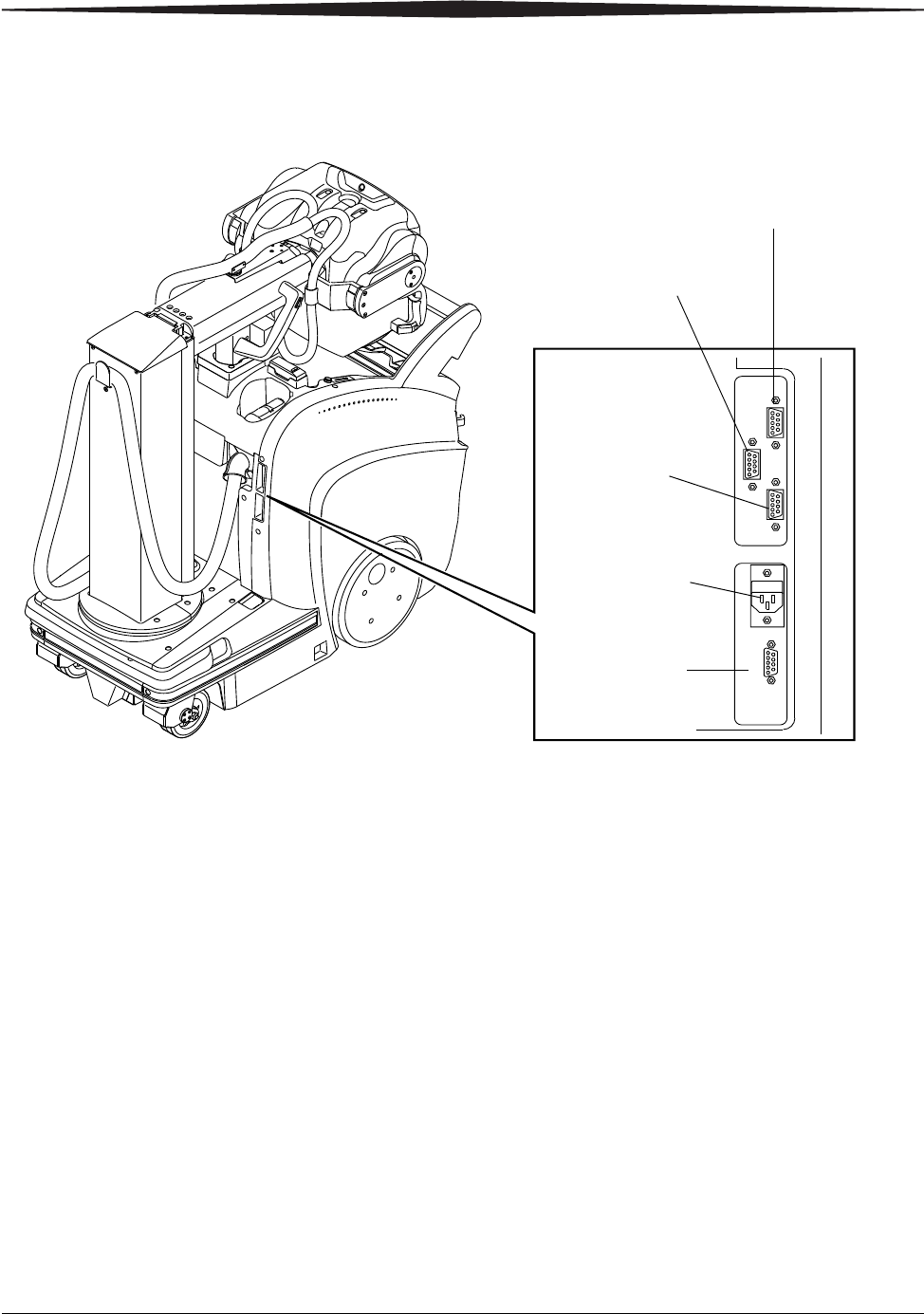
Safety and Regulatory Information
9J0239 1-17
USB, Network, and Tether Connectors
6HC
USB connector for the 2D bar code reader
USB connector for Service
USB connector for Service
Hospital uplink network
connector
Detector tether
connector

1-18 9J0239
Safety and Regulatory Information
Conforming EMC Standards
For European Market
Only
Carestream Health France
1, rue Gaililée
93192 NOISY-LE-GRAND CEDEX
FRANCE
System Requirements Equipment and systems meet the following requirements:
IEC 60601–1-2: 2001+ A1:2004 Medical Electrical
Equipment—Electromagnetic Compatibility Requirements and Tests,
including CISPR 11:2003 + A2:2006 emissions to Class A limits.
CAUTION:
This is a Class A product. In a domestic environment this
product may cause radio interference, in which case the user
may be required to take adequate measures.
93/42/EEC MDD (Medical Device Directive—Europe Only)
ICES–001 Issue 4: Class A Radiated and Conducted Emission—Canada

Safety and Regulatory Information
9J0239 1-19
US and Canada EMC
Statements
Changes or modifications not expressly approved by Carestream Health, Inc.
could void the user’s authority to operate this equipment.
NOTE: This equipment has been tested and found to comply with the limits
for a Class A digital device, pursuant to part 15 of the FCC Rules.
These limits are designed to provide reasonable protection against
harmful interference when the equipment is operated in a
commercial environment. This equipment generates, uses, and
radiates radio frequency energy. If it is not installed and used in
accordance with the instruction manual, it may cause harmful
interference to radio communications. Operation of this equipment
in a residential area is likely to cause harmful interference, in which
case the user will be required to correct the interference at his own
expense.
This device complies with part 15 of the FCC Rules. Operation is subject to the
following two conditions:
1. This device may not cause interference
2. This device must accept any interference received, including interference
that may cause undesired operation.
This device complies with Industry Canada license–exempt RSS standard(s).
Operation is subject to the following two conditions:
1. This device may not cause interference
2. This device must accept any interference, including interference that may
cause undesired operation of the device.
Le présent appareil est conforme aux CNR d'Industrie Canada applicables aux
appareils radio exempts de licence. L'exploitation est autorisée aux deux
conditions suivantes:
1. L'appareil ne doit pas produire de brouillage
2. L'utilisateur de l'appareil doit accepter tout brouillage radioélectrique
subi, même si le brouillage est susceptible d'en compromettre le
fonctionnement.

1-20 9J0239
Safety and Regulatory Information
Electromagnetic
Emissions/Immunity
1. Electromagnetic Compatibility Precautions
Medical electrical equipment requires special precautions regarding
electromagnetic compatibility (EMC). Medical equipment must be
installed and put into service according to the EMC information
provided.
2. Communications Equipment
Portable and mobile radio frequency (RF) communications equipment
can affect medical electrical equipment EMC performance.
3. Replacement of cables, or accessories, other than those specified below
with the exception of transducers or cables sold by the equipment
manufacturer as replacement parts for internal components, may result
in increased emissions or decreased immunity of the medical
equipment.
4. Cable and accessory information for the system:
5. Shielded Locations
The System must be used in a shielded room for personal safety only, and
is fully compliant with the requirements of IEC 60601–1–2:2007 without
being used in a shielded room.
Cable Information for the System
Port/Cable Function User Cable
Length
USB
1 BlueTooth Customer NA
2 Keyboard/Mouse/DVD Service 1 Meter
3 Keyboard/Mouse/DVD Service 1 Meter
Ethernet 1 Hospital Uplink Customer 3 Meter
Ethernet 1 Tethered Detector Link Customer/
Service
3 Meter
Prep/Expose Hand Switch 1 Prep/Expose/Collimator Light
Controller
Customer 3 Meter
AC Power Cord 1 Retractable — 3 Meter

Safety and Regulatory Information
9J0239 1-21
Electromagnetic Emissions for Group 1, Class A Equipment
The System is intended for use in the electromagnetic environment specified below. The customer or the user of the
System should assure that it is used in such an environment.
Emissions Test Compliance Electromagnetic Environment - Guidance
RF Emissions
CISPR 11
Group 1 The System uses RF energy only for its internal function.
Therefore, its RF emissions are very low and are not likely to cause
any interference in nearby electronic equipment.
RF Emissions
CISPR 11
Class A The System is suitable for use in all establishments other than
domestic establishments and those directly connected to the
public low-voltage power supply network that supplies buildings
for domestic purposes.
Harmonics Emissions
IEC 61000–3–2
Class A
Voltage
Fluctuations/
Flicker Emissions
IEC 61000–3–3
Complies

1-22 9J0239
Safety and Regulatory Information
Electromagnetic Immunity for Equipment and Systems Fully Compliant with IEC
60601-1-2:2004
The System is intended for use in the electromagnetic environment specified below. The customer or the user of the
System should assure that it is used in such an environment.
Immunity Test IEC 60601
Test Level
Compliance
Level
Electromagnetic Environment -
Guidance
Electrostatic Discharge (ESD)
IEC 61000–4–2
± 6 kV contact
± 8 kV air
± 6 kV contact
±8 kV air
Floors should be wood, concrete or
ceramic tile. If floors are covered with
synthetic material, the relative humidity
should be at least 30%.
Electrical fast transient/burst
IEC 61000–4–4
± 2 kV for
power supply
lines
± 1 kV for
input/output
lines
± 2 kV for
power supply
lines
± 1 kV for
input/output
lines
Mains power quality should be that of a
typical commercial or hospital
environment.
Surge
IEC 61000-4-5
±1 kV
differential
mode
± 2 kV common
mode
±1 kV
differential
mode
±2 kV common
mode
Mains power quality should be that of a
typical commercial or hospital
environment.
Voltage dips, short interruptions
and voltage variations on power
supply lines
IEC 61000-4-11
<5 % Ur
(>95 % dip in
Ur) for 0.5 cycle
40 % Ur
(60 % dip in Ur)
for 5 cycles
70 % Ur
(30 % dip in Ur)
for 25 cycles.
<5 % Ur
(>95 % dip in
Ur) for 5 s
<5 % Ur
(>95 % dip in
Ur) for 0.5 cycle
40 % Ur
(60 % dip in Ur)
for 5 cycles
70 % Ur
(30 % dip in Ur)
for 25 cycles.
<5 % Ur
(>95 % dip in
Ur) for 5 s
Mains power quality should be that of a
typical commercial or hospital
environment. If the user of the System
requires continued operation during power
mains interruptions, it is recommended that
the System be powered from an alternate AC
power source.
Power frequency
(50/60Hz)magnetic field
IEC 61000-4-8
3 A/m 3 A/m Power frequency magnetic fields should be
at levels characteristic of a typical location
in a typical commercial or hospital
environment.
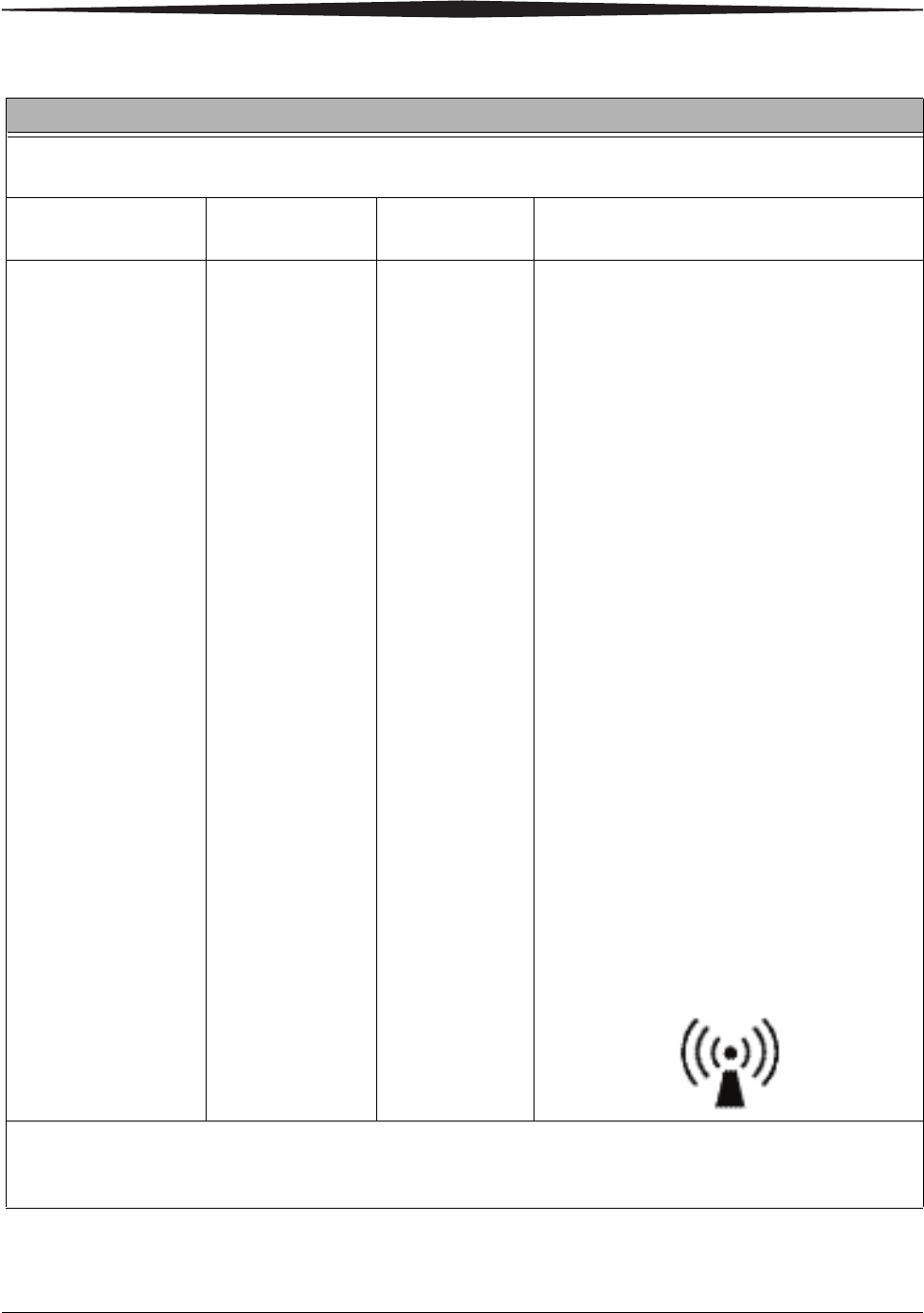
Safety and Regulatory Information
9J0239 1-23
Electromagnetic Immunity for Non-Life Supporting Equipment and Systems
The System is intended for use in the electromagnetic environment specified below. The customer or the user of the
System should assure that it is used in such an environment.
Immunity Test IEC 60601
Test Level
Compliance
Level
Electromagnetic Environment - Guidance
Conducted RF
IEC 61000–4–6
Radiated RF
IEC 61000–4–3
3 Vrms
150 kHz to 80 MHz
3 v/m
80 MHz to 2.5 GHz
3 Vrms
3 v/m
Portable and mobile RF communications
equipment should be used no closer to any part
of the System, including cables, than the
recommended separation distance calculated
from the equation applicable to the frequency of
the transmitter.
Recommended separation distance
d = 1.17 P
d = 1.17 P 80 MHz to 800 MHz
d = 2.33 P 800 MHz to 2.5 GHz
where P is the maximum output rating of the
transmitter in watts (W) according to the
transmitter manufacture and d is recommended
separation distance in meters (m).
Field strengths from fixed RF transmitters, as
determined by an electromagnetic site surveya,
should be less than the compliance level in each
frequency rangeb.
Interference may occur in the vicinity of
equipment marked with the following symbol:
NOTE 1: At 80 MHz and 800 MHz, the higher frequency range applies.
NOTE 2: These guidelines may not apply in all situations. Electromagnetic propagation is affected by absorption and
reflection from structures, objects and people.

1-24 9J0239
Safety and Regulatory Information
a Field strengths from fixed transmitters, such as base station for radio (cellular/cordless) telephones and land
mobile radios, amateur radio, AM and FM radio broadcast and TV broadcast cannot be predicted theoretically with
accuracy. To assess the electromagnetic environment due to fixed RF transmitters, an electromagnetic site survey
should be considered. If the measured field strength in the location in which the System is used exceeds the
applicable RF compliance level above, the System should be observed to verify normal operation. If abnormal
performance is observed, additional measures may be necessary, such as reorienting or relocating the System.
b Over the frequency range 150 kHz to 80 MHz, field strengths should be less than 3 v/m.
Electromagnetic Immunity for Non-Life Supporting Equipment and Systems

Safety and Regulatory Information
9J0239 1-25
Recommended Separation Distance Between Portable and Mobile RF
Communications Equipment and the System
The System is intended for use in an electromagnetic environment in which radiated RF disturbances are controlled.
The customer or the user of the System can help prevent electromagnetic interference by maintaining a minimum
distance between portable and mobile RF communication equipment (transmitters) and the System as recommended
below, according to the maximum output of the communications equipment.
Rated Maximum Output
Power of Transmitter
Watts
Separation Distance According to Frequency of Transmitter
Meters
150 kHz to 80 MHz
d = 1.17 P
80 MHz to 800 MHz
d = 1.17 P
800 MHz to 2.5 GHz
d = 2.33 P
0.01 0.117 0.117 0.233
0.10 0.370 0.370 0.737
1.00 1.170 1.170 2.3300
10.00 3.700 3.700 7.3600
100.00 11.700 11.700 23.300
For transmitters rated at a maximum output power not listed above, the recommended separation distance (d) in
meters (m) can be estimated using the equation applicable to the frequency of the transmitter, where P is the
maximum output power rating of the transmitter in watts (W) according to the transmitter manufacturer.
NOTE 1: At 80 MHz and 800 MHz, the separation distance for the higher frequency range applies.
NOTE 2: These guidelines may not apply in all situations. Electromagnetic propagation is affected by absorption and
reflection from structures, objects and people.

1-26 9J0239
Safety and Regulatory Information
Electromagnetic Emissions for Group 1, Class A Equipment
The System is intended for use in the electromagnetic environment specified below. The customer or the user of the
System should assure that it is used in such an environment.
Emissions Test Compliance Electromagnetic Environment - Guidance
RF Emissions
CISPR 11
Group 1 The System uses RF energy only for its internal function.
Therefore, its RF emissions are very low and are not likely to cause
any interference in nearby electronic equipment.
RF Emissions
CISPR 11
Class A The System is suitable for use in all establishments other than
domestic establishments and those directly connected to the
public low-voltage power supply network that supplies buildings
for domestic purposes.
Harmonics Emissions
IEC 61000-3-2
Not
Applicable
Voltage
Fluctuations/
Flicker Emissions
IEC 61000-3-3
Not
Applicable

Safety and Regulatory Information
9J0239 1-27
Recommended Separation Distance Between Portable and Mobile RF
Communications Equipment and the System
The System is intended for use in an electromagnetic environment in which radiated RF disturbances are controlled.
The customer or the user of the System can help prevent electromagnetic interference by maintaining a minimum
distance between portable and mobile RF communication equipment (transmitters) and the System as recommended
below, according to the maximum output of the communications equipment.
Rated Maximum Output
Power of Transmitter
Watts
Separation Distance According to Frequency of Transmitter
Meters
150 kHz to 80 MHz
d = 1.17 P
80 MHz to 800 MHz
d = 1.17 P
800 MHz to 2.5 GHz
d = 2.33 P
0.010 0.117 0.117 0.233
0.100 0.370 0.370 0.737
1.000 1.170 1.170 2.330
10.000 3.700 3.700 7.360
100.000 11.700 11.700 23.30
For transmitters rated at a maximum output power not listed above, the recommended separation distance (d) in
meters (m) can be estimated using the equation applicable to the frequency of the transmitter, where P is the
maximum output power rating of the transmitter in watts (W) according to the transmitter manufacturer.
NOTE 1: At 80 MHz and 800 MHz, the separation distance for the higher frequency range applies.
NOTE 2: These guidelines may not apply in all situations. Electromagnetic propagation is affected by absorption and
reflection from structures, objects and people.

1-28 9J0239
Safety and Regulatory Information
Wireless
DRX-Revolution
Wireless Systems
• CARESTREAM DRX-1 or DRX-1C System Detector
• DLink DAP 2553 Access Point
• CARESTREAM Grid Alignment Trasmitter
• RF Ideas Model RDR–80_82AKU Proximity Badge Reader
• Code Corp. Radio Modem, Model CR2AG–R0–01–02 Bar Code Reader
• Kensington BlueTooth USB Micro Adapter, Model M01011
• Intel Centrino Ultimate N 6300 WLAN module, Model 633AN
DRX-1 and DRX-1C
System Detectors
Radio Frequency Exposure Declaration—See the DRX-Revolution
Mobile X-ray System Safety and Regulatory Information and release
notes for the DRX-1 and DRX-1C System detectors.
Intentional Radiator Wireless Compliance to Regulatory Requirements—See
the DRX-Revolution Mobile X-ray System Safety and Regulatory
Information and release notes for the DRX-1 and DRX-1C detectors.
Grid Alignment
Transmitter
Radio Frequency Exposure Declaration
The Grid Alignment Transmitter is a mobile wireless device according to FCC
regulation 2.1091 (b). The average field strength for RF emissions from the
Grid Alignment Transmitter has been measured at 162 uv/m. The RF
emissions from the transmitter are well under the Maximum Permissible
Exposure limits (614 uv/m) for human exposure to radio frequency
radiation, according to FCC regulation 1.1310, Table 1.
Although the Grid Alignment Transmitter RF emissions are significantly below
FCC limit for human exposure, the transmitter is designed to be used in such
a way that a separation distance of at least 20 cm (approximately 8 in.) is
normally maintained between the transmitter's radiating structure and the
bodies of nearby persons (the mobile cart operators or patients). The
transmitter is located on the tube head assembly (see “Systems Label
Locations” on page 1-39).
Under Industry Canada regulations, this radio transmitter may only operate
using an antenna of a type and maximum (or lesser) gain approved for the
transmitter by Industry Canada.
To reduce potential radio interference to other users, the antenna type and its
gain should be chosen so that the equivalent isotropically radiated power
(e.i.r.p.) is not more than that necessary for successful communication.
Conformément à la réglementation d'Industrie Canada, le présent émetteur
radio peut fonctionner avec une antenne d'un type et d'un gain maximal (ou
inférieur) approuvé pour l'émetteur par Industrie Canada.

Safety and Regulatory Information
9J0239 1-29
• DLink DAP 2553 Access Point
• RF Ideas Model RDR–80_82AKU Proximity Badge Reader
• Bar Code Reader (Code Corp. Radio Modem, Model CR2AG–R0–01–02)
• Kensington BlueTooth USB Micro Adapter, Model M01011
• Intel Centrino Ultimate N 6300 WLAN module, Model 633AN
Refer to the appropriate manufacturer documentation for wireless regulatory
declarations.
The CARESTREAM DRX-Revolution Mobile X-ray System uses the same vendor,
type, and model antennae originally certified with the Intel 6300 WLAN
module and the DLink DAP 2553 Access Point.
Wireless Compliance
Information for EU
Directive 1999/5/IEC
Grid Alignment Intended
Use
When the user obtains an X-ray image, there is generally an optimal alignment
between the radiation source and the two-dimensional receptor that records
the image data. In most cases, the X-ray source provides radiation in a
direction that is perpendicular to the receptor. Use of an anti-scatter grid can
significantly improve the quality of X-ray images. When using a grid, the
requirements for good alignment are much more stringent. For mobile X-ray
systems, the receptor is placed behind the patient and is blocked from the
operator’s view by the patient, bedding, and so forth. This makes it very
difficult to align the X-ray source to the detector properly. The grid helps an
operator achieve the correct alignment.
Principle of OperationX
The Grid Alignment System uses transmitter emitter coils mounted on the
X-ray source to produce a rotating magnetic field vector.
Magnetic field sense coils are mounted in the perimeter of a frame that holds
the grid and and DRX-1 detector. The signal from the emitter is seen by the
sense coils. The processor on the cart interprets the signals to determine the
relative alignment of the X-ray tube and the detector, and displays it on a
graphical user interface.

1-30 9J0239
Safety and Regulatory Information
EC Declaration of Conformity
EC Declaration of Conformity to R&TTE Directive 1999/5/EC
Manufacturer: Carestream Health, Inc.
150 Verona Street
Rochester, New York 14608
United States
EU Representative: Carestream Health, France
1, rue Galilée
93192 NOISY-LE-GRAND Cedex
France
Product:
Type Number:
DRX-Revolution Grid Alignment Transmitter
DRXRGA
Declaration
We, Carestream Health, declare under our own responsibility that this equipment is in compliance
with the essential requirements and other relevant provisions of Directive 1999/5/EC
Wireless Standard: ETSI EN 301 489–V1.8.1
ETSI EN 300 330 Sections 7.3, 7.4, 7.5, 7.5.4
EMC Standard: EN 55022:2006 + A1:2007 (Emissions)
EN 61000–4–2:2009 (Immunity Electrostatic Discharge)
EN 61000–4–3:2006 + A1:2007 + A2:2010
(Immunity Radiated RF Electromagnetic Field)
Product Safety Standard: EN 60601–1 1990: + A1:1993 + A2:1995
EN 60601–1–1:2001

Safety and Regulatory Information
9J0239 1-31
The Grid Alignment Transmitter may be operated in all European Union
countries listed below (and other countries following the EU Directive
1999/5/EC R&TTE) without restrictions.
National Usage
Restrictions
NOTE: There are no restrictions on operation of the Grid Alignment
Transmitter in the countries listed above.
Refer to the appropriate manufacturer documentation for European Union
wireless regulatory declarations for the following products:
• RF Ideas Model RDR–80_82AKU Proximity Badge Reader
• Bar Code Reader (Code Corp. Radio Modem,
Model CR2AG–R0–01–02)
• Kensington BlueTooth USB Micro Adapter, Model M01011
• Intel Centrino Ultimate N 6300 WLAN module, Model 633AN
Austria at Liechtenstein li
Belgium be Lithuania lt
Bulgaria bg Luxembourg lu
Cyprus cy Malta mt
Czech Republic cz Netherlands nl
Denmark da Norway no
Estonia ee Poland pl
Finland fi Portugal pt
France fr Romania ro
Germany de Slovakia sk
Greece el Slovenia sl
Hungary hu Spain es
Iceland ie Sweden se
Ireland is Switzerland ch
Italy it United Kingdom gb
Latvia lv
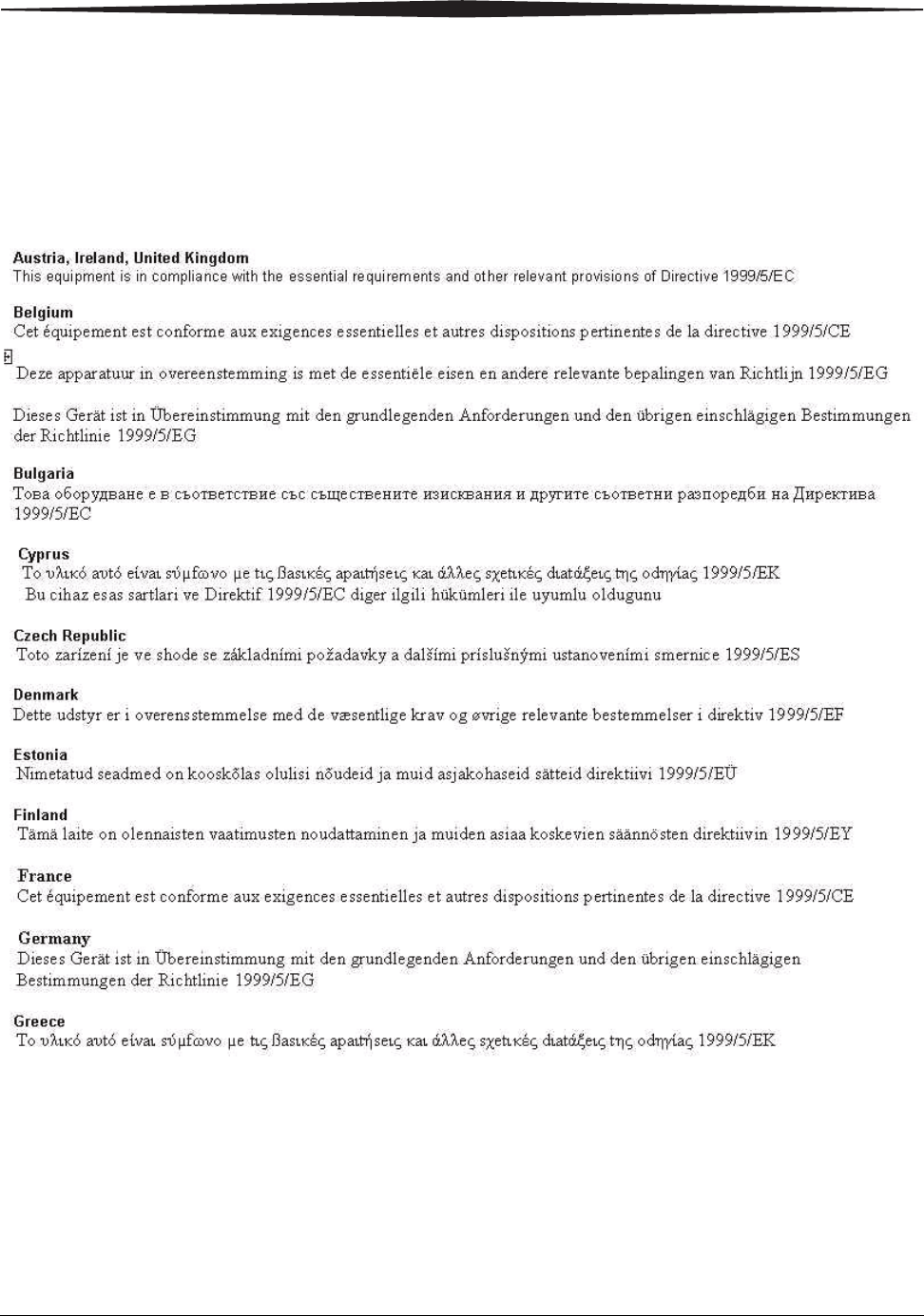
1-32 9J0239
Safety and Regulatory Information
Compliance
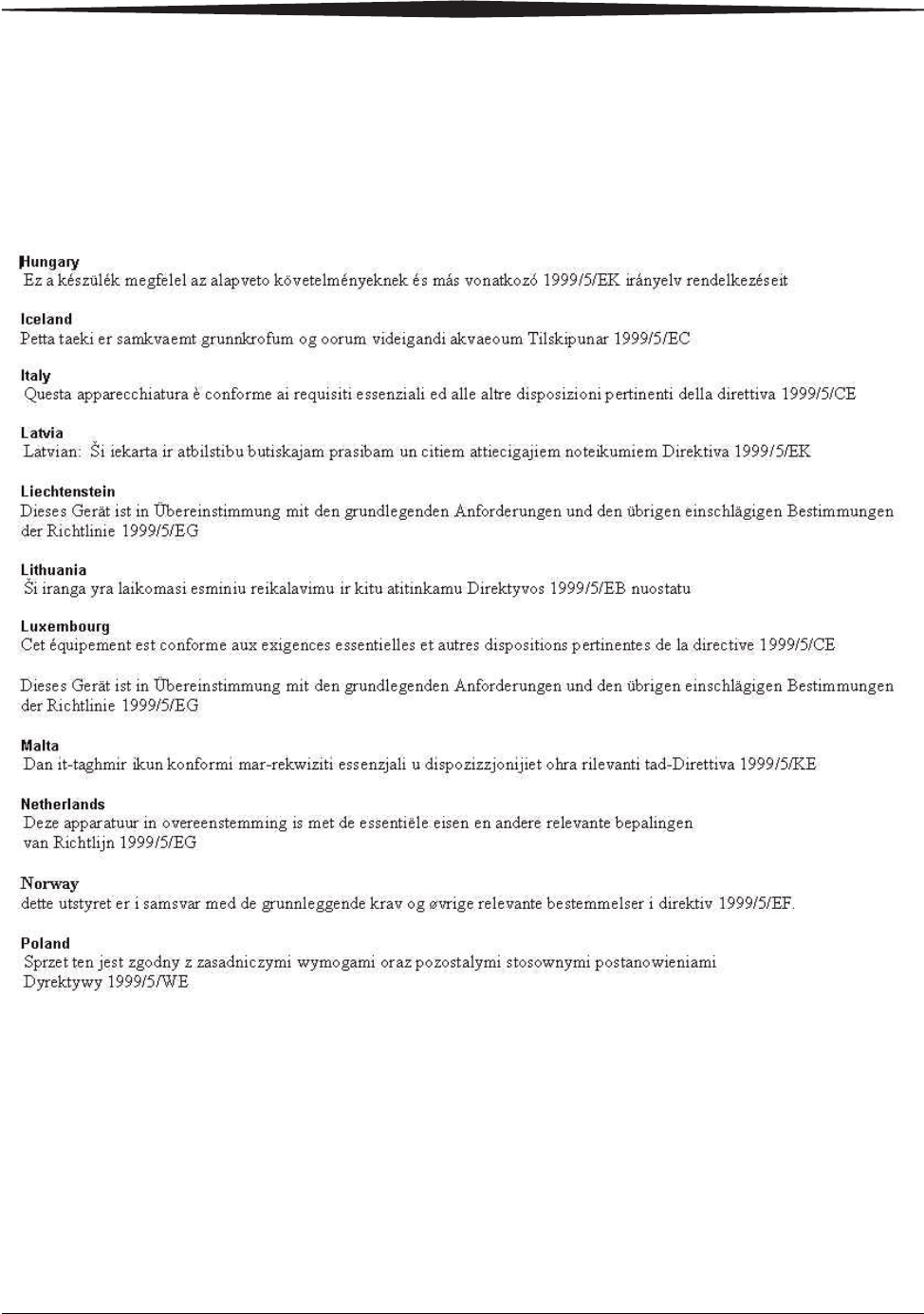
Safety and Regulatory Information
9J0239 1-33
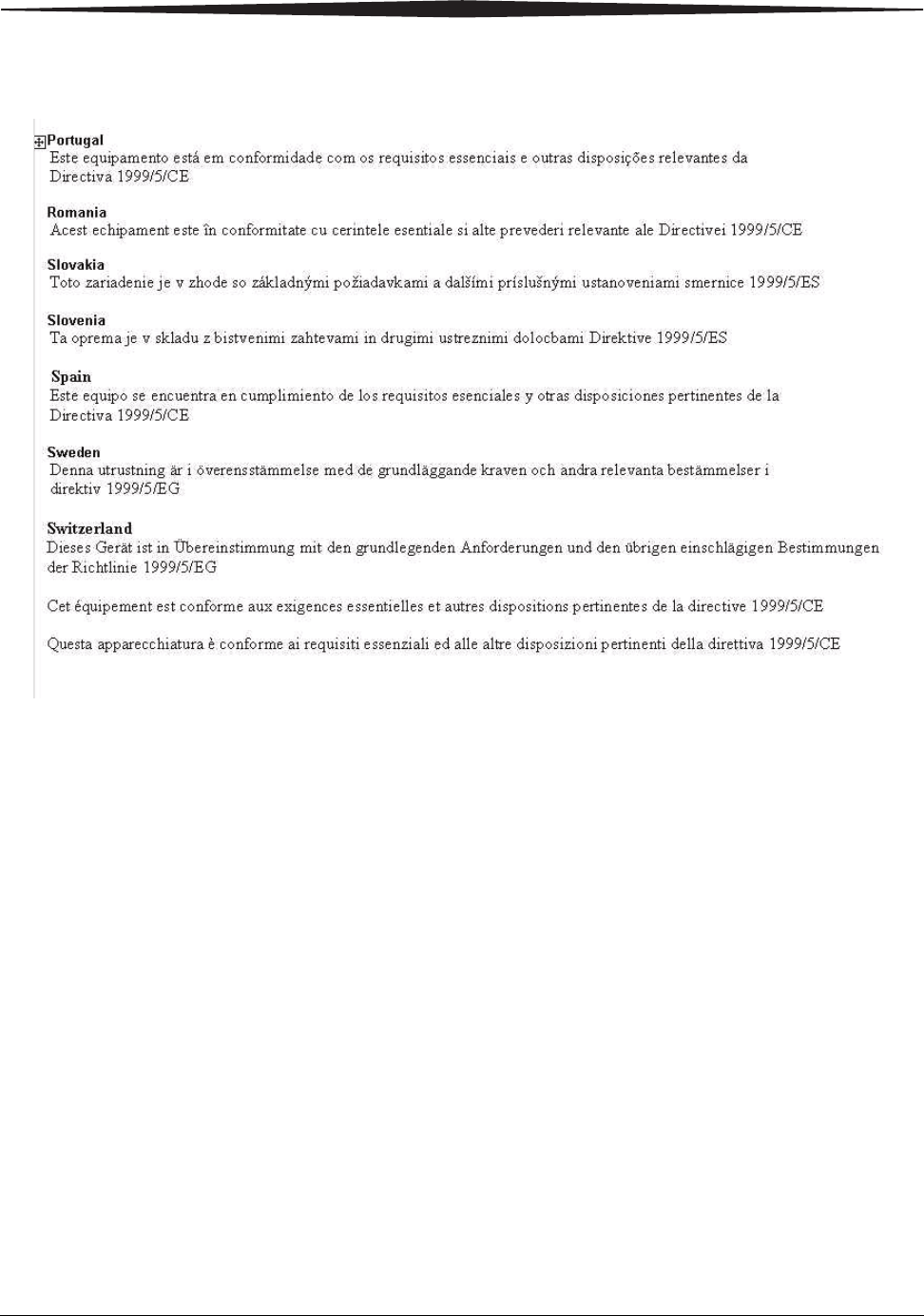
1-34 9J0239
Safety and Regulatory Information
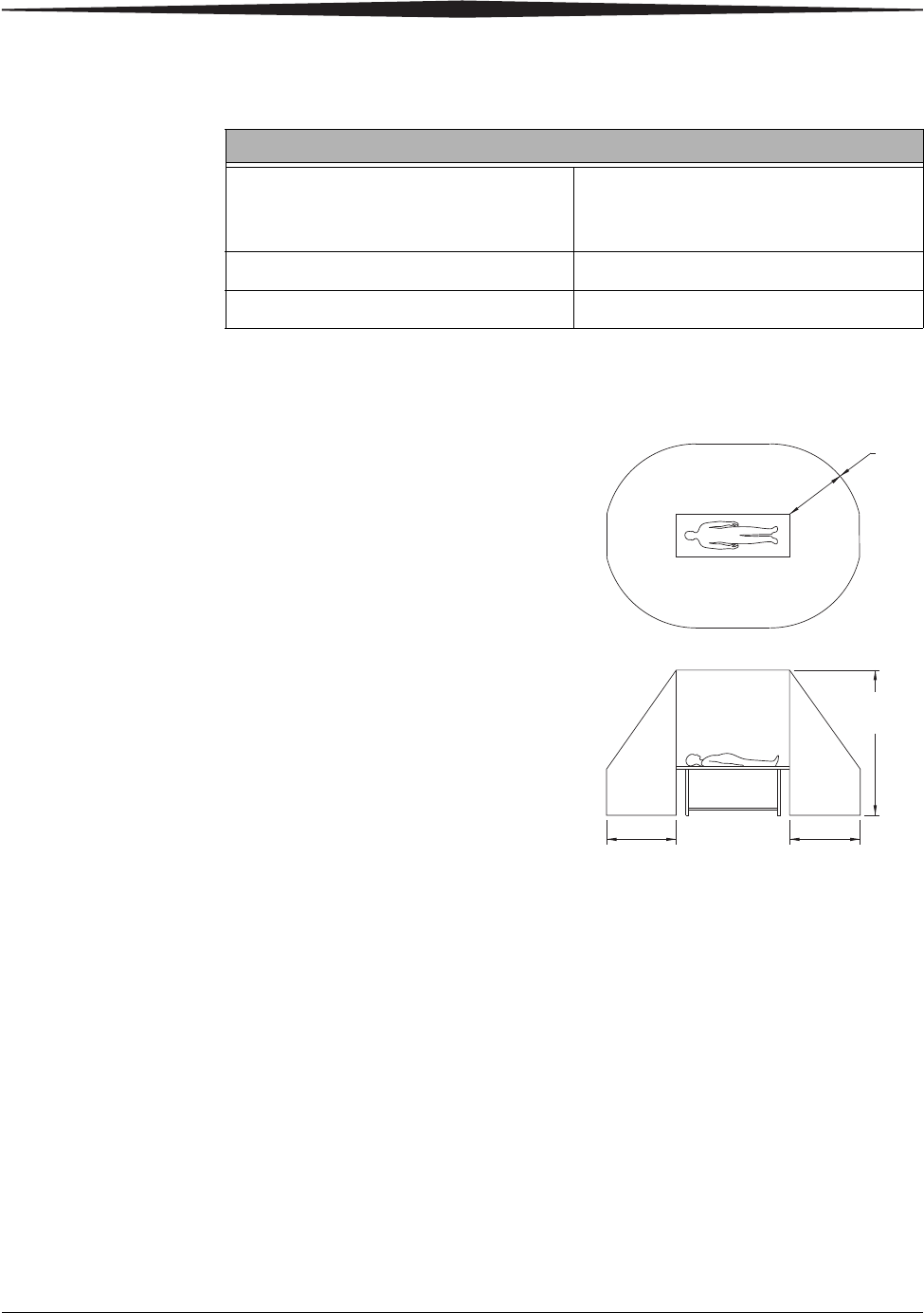
Safety and Regulatory Information
9J0239 1-35
Anti-Collision Feature
Patient Vicinity
Compatible Components
X-ray Tube
Components
Either:
• VARIAN Diamond housing with a RAD 68 insert
• Inherent Filtration = 0.7 mm Al
X-ray Source
Assembly
Total Inherent Filtration = 2.7 mm Al
Drive System
Motor Drive Two independent drive motors provide
forward/reverse drive and directional
control.
Collision Sensing Frontal and Lateral
Maximum Drive Speed Up to 5.6 kmvh (3.5 mph)
H196_0004GC
1.83 m
2.5 m
1.83 m
1.83 m
(6.00 ft)(6.00 ft)
(6.00 ft)
(8.0 ft)

1-36 9J0239
Safety and Regulatory Information
Accessories The following items are accessories for the system:
• CARESTREAM DRX-1 System Detector
• CARESTREAM Grid Holder
• 2D Barcode reader
• Remote Exposure Switch
• Dose Area Product Meter
Flammability Not suitable for use in the presence of a flammable anesthetic mixture with
oxygen or nitrous oxide.
IMPORTANT: Instructions are provided to indicate the type of
attachment plug that should be used for connection to the
alternate voltage.
Method of Cleaning See the DRX-Revolution Mobile X-ray System Hardware Guide for
instructions on cleaning the equipment.
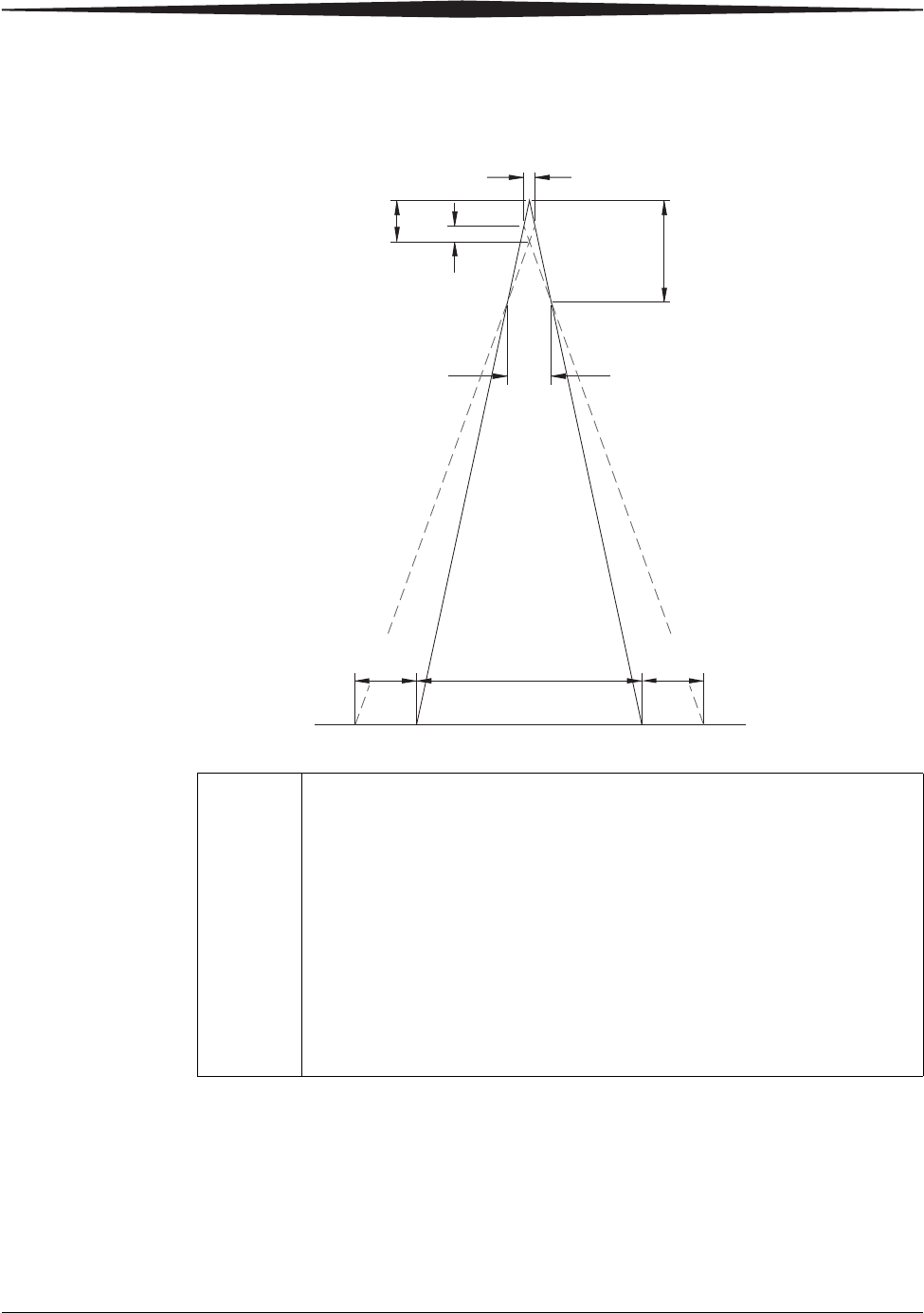
Safety and Regulatory Information
9J0239 1-37
Extra Focal Dimensions
Key:
GHH
A
B
C
E
F
D
430.0 mm
(16.9 in.)
21.0 mm
(0.8 in.)
80.0 mm
(3.1 in.) 184.0 mm
(7.2 in.)
79.0 mm
(3.1 in.)
35.0 mm
(1.4 in.)
117.4 mm
(4.6 in.)
117.4 mm
(4.6 in.)
A Distance from the focal spot to the collimator mounting flange surface
B Distance from the near-focus shutter opening to the mounting flange surface
C The maximum opening size of near-focus shutters
D The maximum size of far-focus shutters
E The distance from the focal spot to the far-focus shutters
F Focal spot position
G Primary X-ray field
H Extra focal radiation
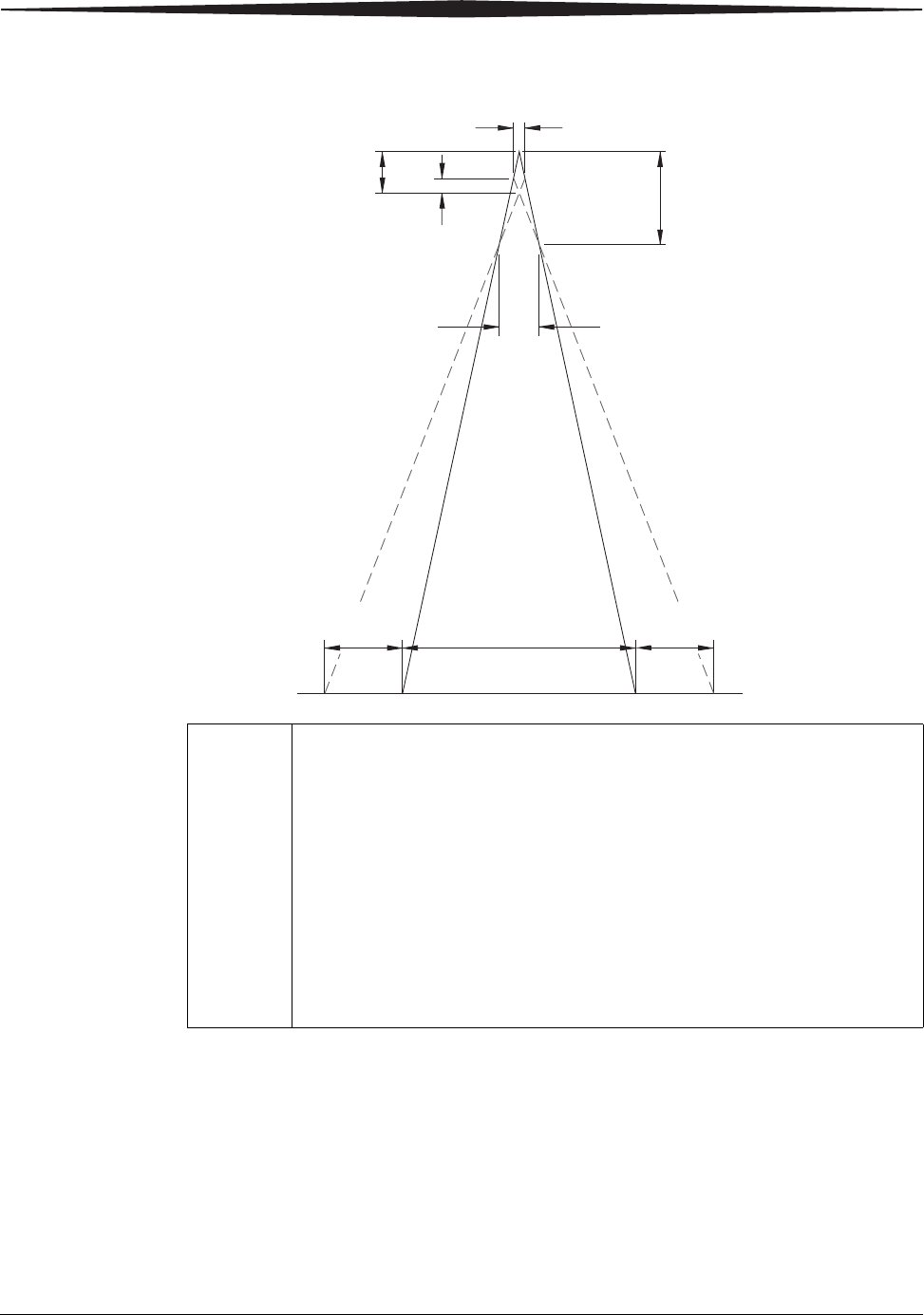
1-38 9J0239
Safety and Regulatory Information
A Distance from the focal spot to the collimator mounting flange surface
B Distance from the near-focus shutter opening to the mounting flange surface
C The maximum opening size of near-focus shutters
D Maximum size of far-focus shutters
E Distance from the focal spot to the far-focus shutters
F Focal spot position
G Primary X-ray field
H Extra focal radiation
GHH
A
B
C
E
F
D
H239_8000GC
430.0 mm
(16.9 in.)
143.8 mm
(0.6 in.)
143.8 mm
(0.6 in.)
74.0 mm
(2.9 in.)
172.0 mm
(6.8 in.)
21.0 mm
(0.8 in.)
80.0 mm
(3.1 in.)
30.5 mm
(1.2 in.)
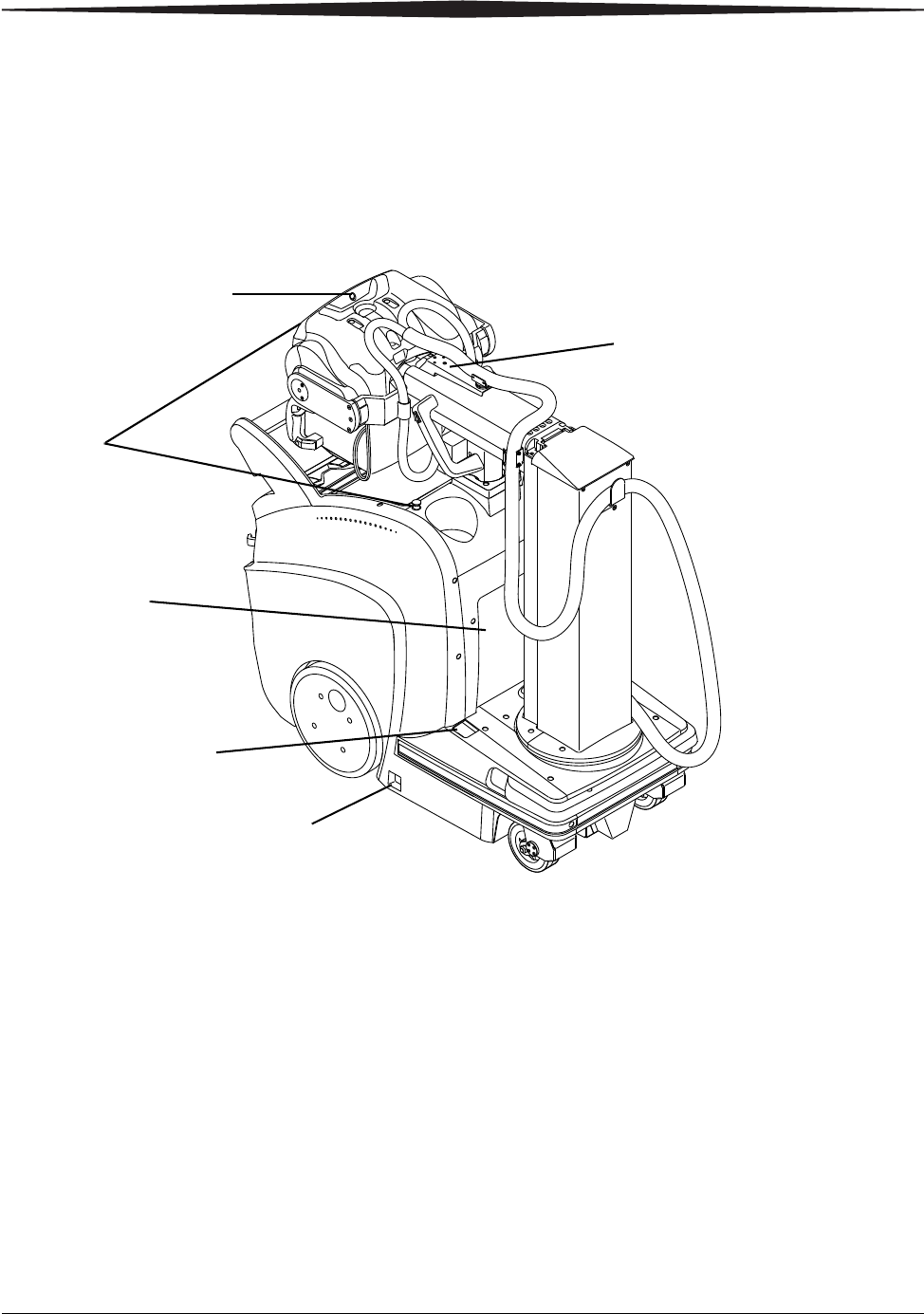
Safety and Regulatory Information
9J0239 1-39
Labels
Systems Label
Locations
1 System Data Plate
2 Generator label
3 X-ray tube label
4 Collimator label
5 Emergency Stop label (2)
6. AC voltage circuit breaker label (The DC voltage circuit breaker label is in the
same location on the opposite side.)
7. Transport position warning label
8. Retractable power cord
9. Ionizing radiation label
9_0002HC
1, 2, 3, 4
5
8
6
7
9
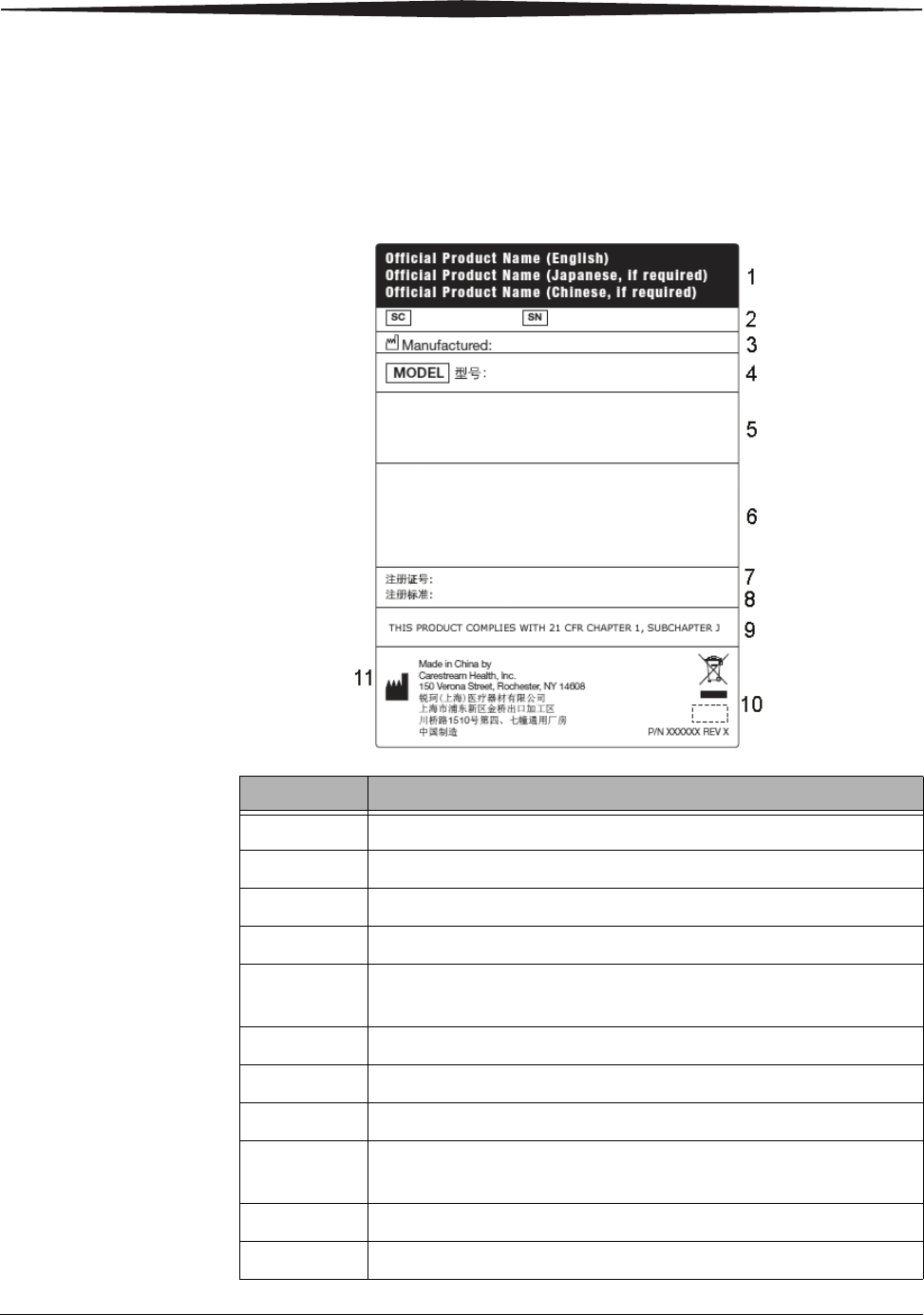
1-40 9J0239
Safety and Regulatory Information
NOTE: The generator, X-ray tube, and collimator labels are located behind
the system covers. The label locations as shown display the external
labels with pertinent information from the manufacturers.
System Data Plate Sample
Area No. Description
1 Official product name
2 Service code and serial number
3 Manufactured date
4 Model type as required / consistent with product safety test reports
5 Voltage range, rated frequency in hertz and amps / consistent with
product safety test reports: V = volts, Hz = hertz, A = amperes
6 Symbols for product safety, EMC, and CE marking
7 SFDA Registration number
8 SFDA Product Standard number
9 Compliance statement according to FDA requirements for radiation
emitting products.
10 Label manufacturer registration number and material specification
11 Made in China by (signature)
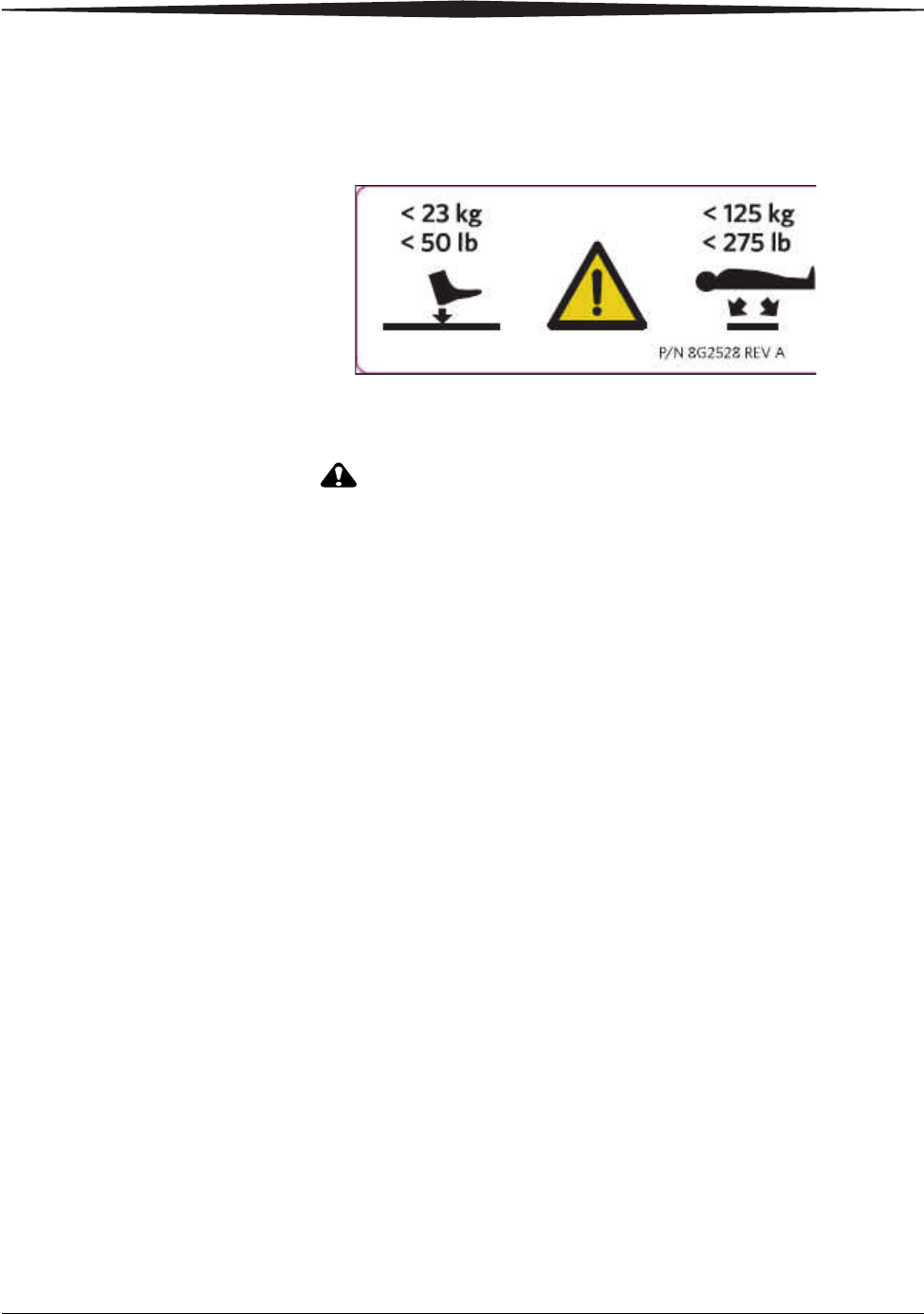
Safety and Regulatory Information
9J0239 1-41
Detector /Grid Holder
Weight Limit Label
CAUTION:
Since the detector/grid is not a patient support device, it must
be placed on a suitable surface, such as a table or a floor,
before applying patient weight. The weight label indicates the
acceptable limits of use that will not damage the detector. To
prolong the life of the detector, and minimize potential
internal detector damage, observe the following weight
restrictions:
• The maximum concentrated weight over a small area of the detector/grid
surface (50 mm diameter) must not exceed 23 kg (50 lb).
• The maximum distributed weight applied uniformly over the entire
detector/grid surface is 125 kg (275 lb).

1-42 9J0239
Safety and Regulatory Information
Product Disclosure Table
Product Disclosure Table
᳝
᳝↦᳝ᆇ⠽䋼ܗ㋴ৡ⿄ঞ䞣ᷛ䆚㸼
Table of hazardous substances’ name and concentration
᳝↦᳝ᆇ⠽䋼ܗ㋴
hazardous substances’ name
䚼ӊৡ⿄
Component name 䪙
(Pb)
∲
(Hg)
䬝
(Cd)
݁Ӌ䫀
(Cr6+)
⒈㘨㣃
(PBB)
⒈Ѡ㣃䝮
(PBDE)
Ẕ⌟఼ (Detector) XOO O O O
Xᇘ㎮ㅵ
(X-ray Tube) XOO O O O
⬉䏃ᵓ (Circuit Board) XOO O O O
ޚⳈҾ (Collimator) XOO O O O
Xᇘ㒓催य़থ⫳఼
(X-ray Generator) XOO X O O
o: 䆹᳝↦᳝ᆇ⠽䋼䆹䚼ӊ᠔᳝ഛ䋼ᴤ᭭Ёⱘ䞣ഛ SJ/T 11363-2006 㾘ᅮⱘ䰤䞣㽕∖ҹϟDŽ
×: 䆹᳝↦᳝ᆇ⠽䋼㟇ᇥ䆹䚼ӊⱘᶤϔഛ䋼ᴤ᭭Ёⱘ䞣䍙ߎ SJ/T 11363-2006 㾘ᅮⱘ䰤䞣㽕∖DŽ
o indicates hazardous substance concentration lower than MCV
×: indicates hazardous substance concentration higher than MCV
⦃ֱՓ⫼ᳳ䰤(383
Ё䰚ˈ䆹ؐ㸼⼎⬉ᄤֵᙃѻકЁ᳝ⱘ᳝↦᳝ᆇ⠽䋼ܗ㋴ℷᐌՓ⫼ⱘᴵӊϟϡӮথ
⫳⊘さবˈ⫼᠋Փ⫼ℸѻકϡӮᇍ⦃๗䗴៤Ϲ䞡∵ᶧᇍҎ䑿ǃ䋶ѻ䗴៤Ϲ䞡ᤳᆇⱘᳳ䰤
˄ҹᑈ䅵˅DŽ
䆹ؐḍ᪡䇈ᯢЁ᠔㾘ᅮⱘѻકℷᐌՓ⫼ᴵӊ㗠ᅮDŽ
Environmental Protection Use Period (EPUP)
In China mainland, this number indicates the time period (calculated by year) within which any
hazardous substances present in the product are not expected to be released such that there is risk
to human health, property, or the environment. This value is assigned based on normal use of the
product as described in the operating instructions.
This value is assigned based on normal use of the product as described in the operating instructions.
H239_0017DA
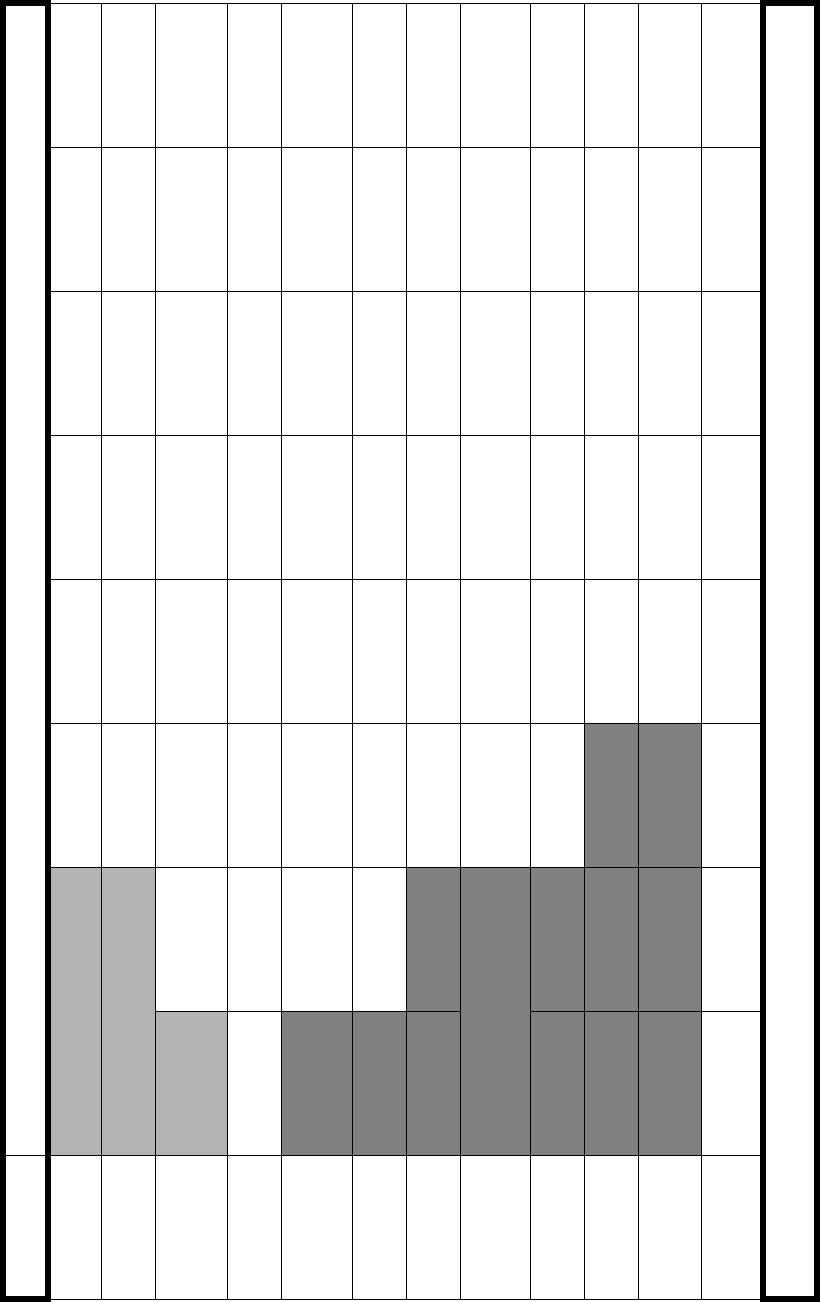
Kv and mAs Selection Table
Table 1: DRX-Revolution kV and mAs Selection Table
kV Selection mAs Selection
40–49 0.5–36.0 mAs 0.36–0.45 [1]
40–320 mAs
0.32 [1] 0.25–0.28 [1] 0.20–0.22 [1] 0.10–0.18 [1]
50–59 X-ray tube emission limited 0.5–36.0 mAs 0.36––0.45 [1]
40–320 mAs
0.32 [1] 0.25–0.28 [1] 0.20–0.22 [1] 0.10–0.18 [1]
60–69 0.71–10.00 mAs 0.5–63.0 [1]
11–22 mAs
0.36––0.45 [1]
25 mAs
0.32 [1] 0.25–0.28 [1]
250–320 mAs
0.20–0.22 [1] 0.10–0.18 [1]
70–79 0.80–9.00 mAs 0.71 [1] mAs 0.5–63 [1]
11 mAs
0.36––0.45 [1]
12.5–22 mAs
0.32 [1]
28–220 mAs
0.25–0.28 [1]
80–320 mAs
0.20–0.22 [1] 0.10–0.18 [1]
80–89 0.71–8.00 mAs 0.5–63.0 [1]
9 mAs
0.36––0.45 [1]
10–18 mAs
0.32 [1]
25–71 mAs
0.25–0.28 [1]
56–320 mAs
0.20–0.22 [1] 0.10–0.18 [1]
90–99 0.71–
7.10 mAs
0.5–63.0 [1]
8 mAs
0.36––0.45 [1]
9 mAs
0.32 [1]
20–50 mAs
0.25–0.28 [1]
20–320 mAs
0.20–0.22 [1] 0.10–0.18 [1]
100–109 0.50–
7.1 mAs
0.36––0.45 [1]
8 mAs
0.32 [1]
10–18 mAs
0.25–0.28 [1]
20–320 mAs
0.20–0.22 [1] 0.10–0.18 [1]
110–119 Exceeds 32 kW 0.5–5.6 mAs 0.36––0.45 [1]
6.3 mAs
0.32 [1]
9–18 mAs
0.25–0.28 [1] 0.20–0.22 [1]
0.8–280 mAs
0.10–0.18 [1]
120–129 0.50–5.00 mAs
[2]
0.36––0.45 [1]
5.6 mAs
0.32 [1
7.1 mAs]
0.25–0.28 [1] 0.20–0.22 [1]
7.1–280 mAs
0.10–0.18 [1]
130–139 0.36––0.45 [1] 0.32 [1]
6.3 mAs
0.25–0.28 [1] 0.20–0.22 [1]
5.6–280 mAs
0.10–0.18 [1]
140–149 0.36––0.45 [1] 0.32 [1]
5 mAs
0.25–0.28 [1] 0.20–0.22 [1]
5.6–280 mAs 0.10–0.18 [1]
150 0.36––0.45 [1] 0.32 [1]
4.5 mAs
0.25–0.28 [1 0.20–22 [1]
5–280 mAs. 0.10–0.18 [1]
[1] indicates that the mA will be reduced so that the minimum exposure time is 2 ms.
[2] indicates that the maximum nominal power is 32.25 kW at 129 kV when in the range of [0.5 to 5] mAs.].

Carestream Health, Inc.
150 Verona Street
Rochester, New York 14608
© Carestream Health, Inc., 2011
CARESTREAM is a trademark of Carestream Health, Inc.
9J0239
Printed in the United States
United States